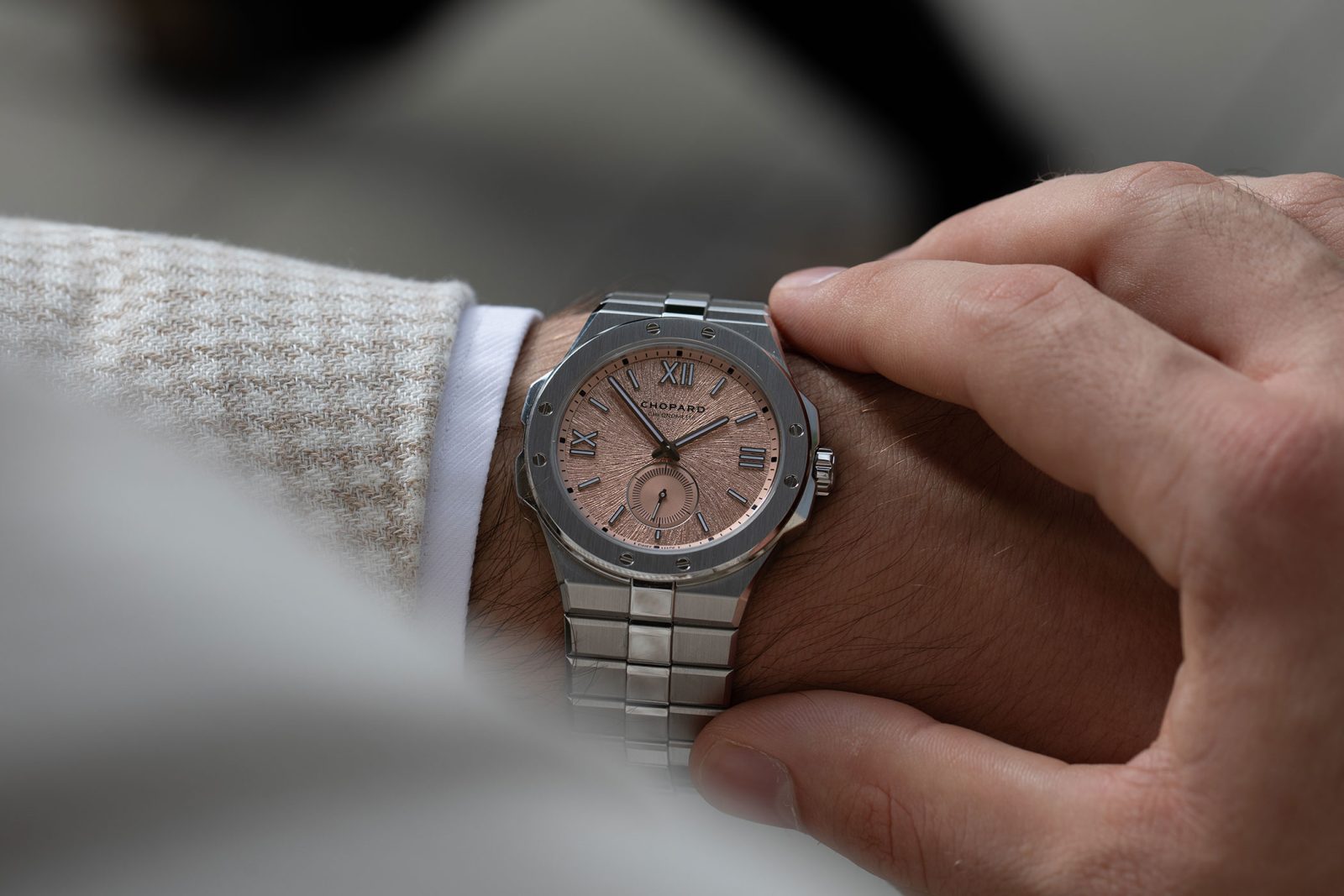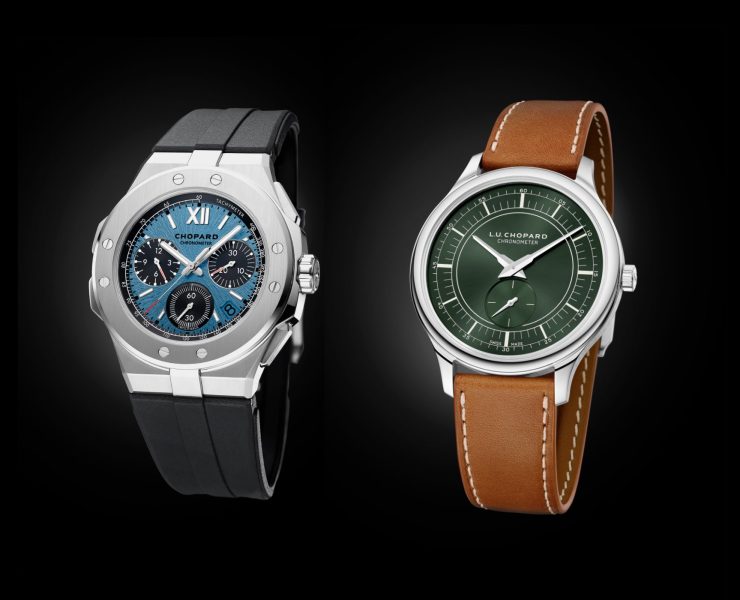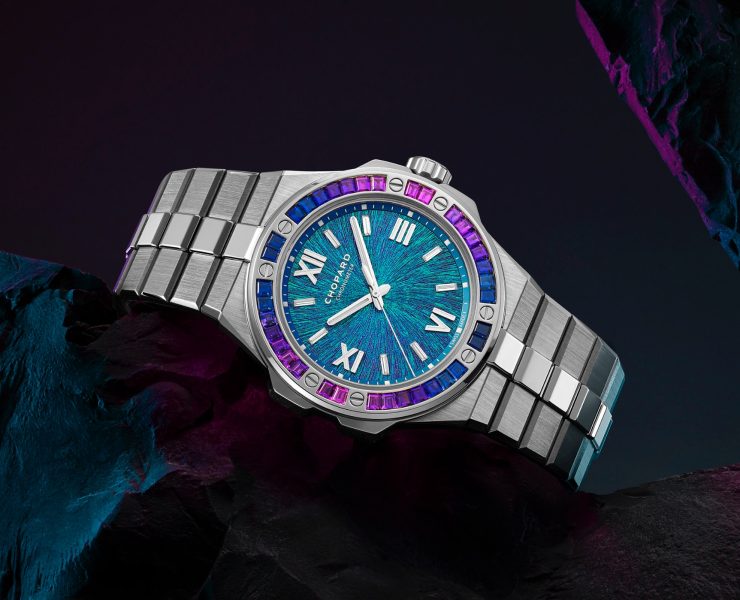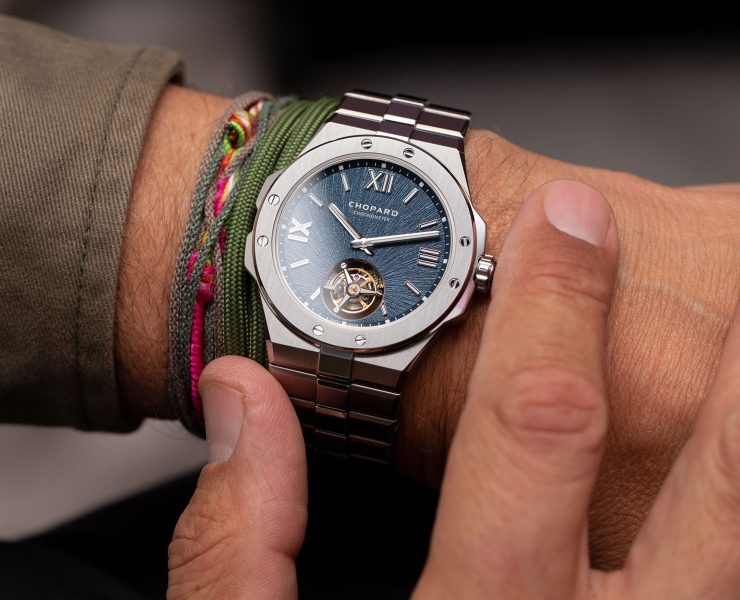When I began my professional entry into the watch industry five years ago, there was no Alpine Eagle. Rather, my first direct contact with Chopard was, as my editor put it at the time, by baptism of fire, as I attended Baselworld on my second week on the job. The year was 2018, and Chopard’s novelties presentation dazzled me with glittering Happy Diamonds watches and a sense of exquisite style. Over the next year, as my horological proficiency grew, I garnered an interest in the brand’s watch portfolio, not least the Mille Miglia chronographs which, in my opinion, remain one of the best and most evocative examples of classic driver’s watches across the board. I was undoubtedly interested in the brand. But, only in 2019, when Chopard launched a new watch named the Alpine Eagle, did I become well and truly enamoured with a Chopard watch model – and I was not the only one seduced by the newly launched timepiece. Little did we know at the time, but the Alpine Eagle’s desirability would grow at a truly unprecedented rate, and soon be competing with some of the most formidable models on the luxury Swiss watch market. The Alpine Eagle is soaring to ever-higher heights. But how did this emblematic piece work its way so effectively – and so rapidly – into becoming a cult classic, and what lies behind its ongoing success?
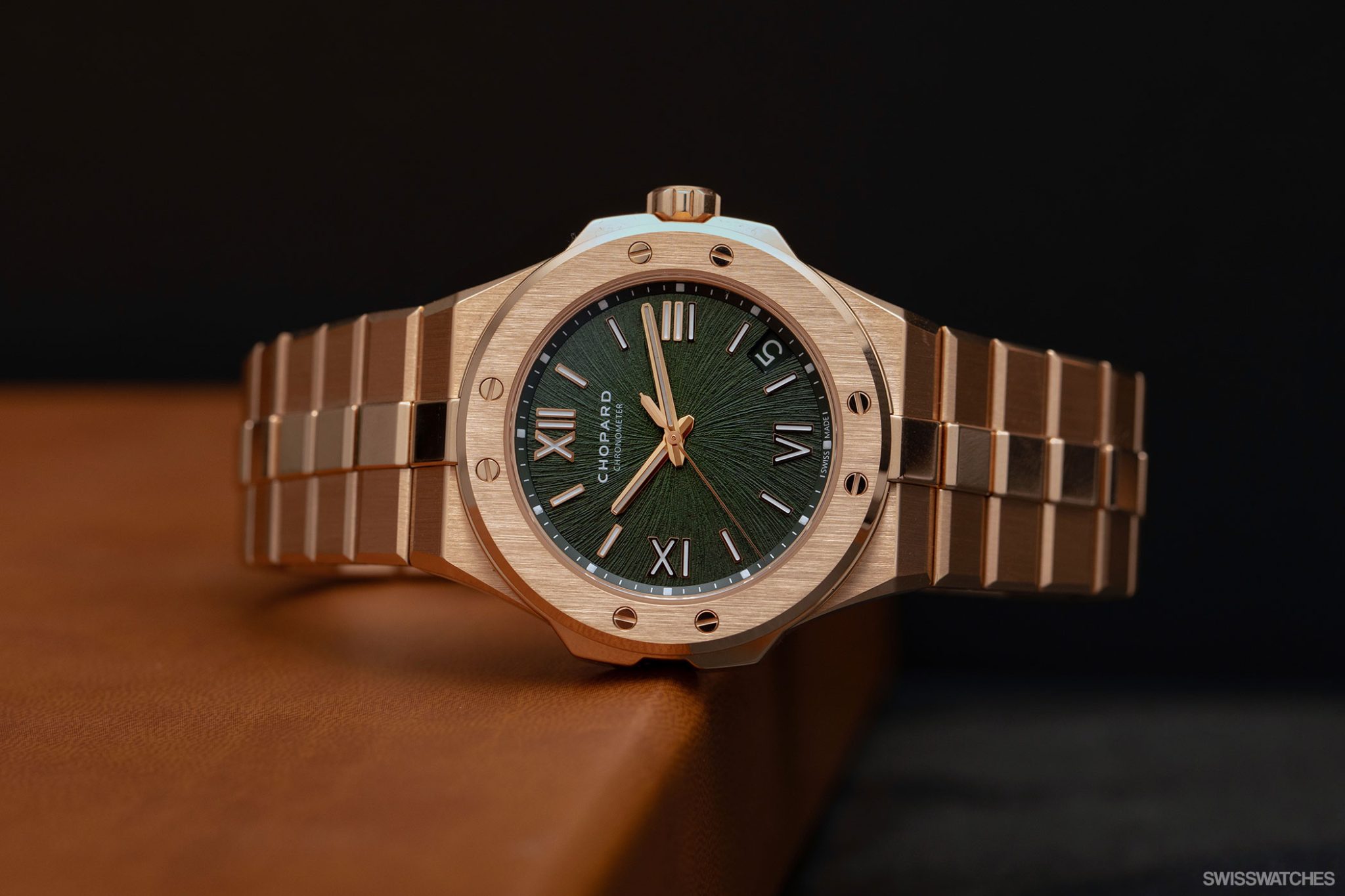
Chopard: A maestro in the industry
In the opulent realm of luxury watches, Chopard is generally regarded as a maestro in the field of precision, while simultaneously offering a level of sophistication that is hard to compete with. Not only technical sophistication, by the way: Chopard’s consumers tend to be equally erudite, as is reflected by its plethora of artistic and cultural personalities that work with the brand, from world-renowned cellist Gautier Capuçon to esteemed actress Julia Roberts. With a legacy dating back to 1860, when visionary Louis-Ulysse Chopard laid the first foundations, Chopard has become a paragon of haute horlogerie as well as exquisite jewellery. From playful Happy Diamonds to advanced L.U.C models, the company’s timepieces, characterised by their innovative design and precision, transcend mere functionality – and this is what makes Chopard a true luxury maison. Yet Chopard also goes beyond conventional luxury by embracing a rarely seen level of commitment to sustainability through its pioneering ‘Journey to Sustainable Luxury’ initiative. Its journey towards sustainable luxury began decisively in 2013, while the brand broke new ground in the industry with its adoption of ethical gold in 2018. Fast-forward to 2023, when Chopard announced the adoption of Lucent Steel for all of its steel watches – a testament to its unwavering commitment to environmental stewardship. Evidently, Chopard is not just as a purveyor of luxury, but a custodian of heritage, innovation, and a sustainable future.

One family’s love of nature and a beacon of conservation: The Alpine Eagle Foundation
It’s worth lingering on the theme of sustainability and pointing out that the Alpine Eagle is, in many ways, the embodiment of the maison’s owners’ – the Scheufele family – love of nature. This is largely imbued into the dial colours and design. For example: the Alpine Eagle ‘Pitch Black’ dial was created at the behest of Chopard Co-President Karl-Friedrich Scheufele, who ‘wanted the hue as a reference to the intense black of mountain nights when wildlife reclaims its rights, reminding us of the extent to which night-time lighting linked to humans and urbanisation disrupts the way of life of surrounding animal species.’

The Alpine Eagle watch’s deep connection to nature is not only aesthetic, however. In honour of its namesake, Chopard’s Alpine Eagle Foundation was created in 2019 by none other than Karl-Friedrich Scheufele in collaboration with several specialists and lovers of the Alps, ‘to raise awareness, mobilise support and take action on behalf of the entire Alpine region and the life it shelters.’ Founded alongside visionaries like falconer Jacques-Olivier Travers and Ronald Menzel of Freedom Conservation, the foundation’s primary aim is ‘Preserving the Alps in all its aspects, from its wildlife to its fauna and glaciers’.

Alongside its focus on the white-tailed eagle’s return to the Lake Geneva region – the foundation plans to release around 80 white-tailed eagles on the shores of Lake Geneva by 2030 – using proceeds from the ‘Pine Green’ Alpine Eagle, a model we will look at later, the organisation is currently on a scientific mission dedicated to safeguarding the golden eagle. In collaboration with the University of Bern, it is working to predict the potential impact of future wind turbine installations in the Swiss Alps on the golden eagle population. This endeavour, in addition to the ongoing white-tailed eagle reintroduction project at the Aigles du Léman wildlife park, underscores Scheufele’s foundation’s commitment to the Alpine ecosystem that inspires his manufacture’s resilient Alpine Eagle watches. It’s certainly a nice – not to mention rarely seen – touch to see such a strong link between a family-run manufacture, its products, and the family’s foundation sitting close to its hearts.

The road to the Alpine Eagle: Three generations unite
As every watch aficionado knows, the steel sports watches produced in the 70s that would one day take the world by storm actually took several years – and some serious pushback – before achieving the reverence they enjoy today. Fortunately, they paved the way for Chopard’s own timely segue into the world of steel sports watches, which came in the form of the St. Moritz at the end of the 70s. While Audemars Piguet and Patek Philippe turned to esteemed designer Gerald Genta for their designs, Chopard went in-house, with Karl-Friedrich Scheufele himself designing the St Moritz.
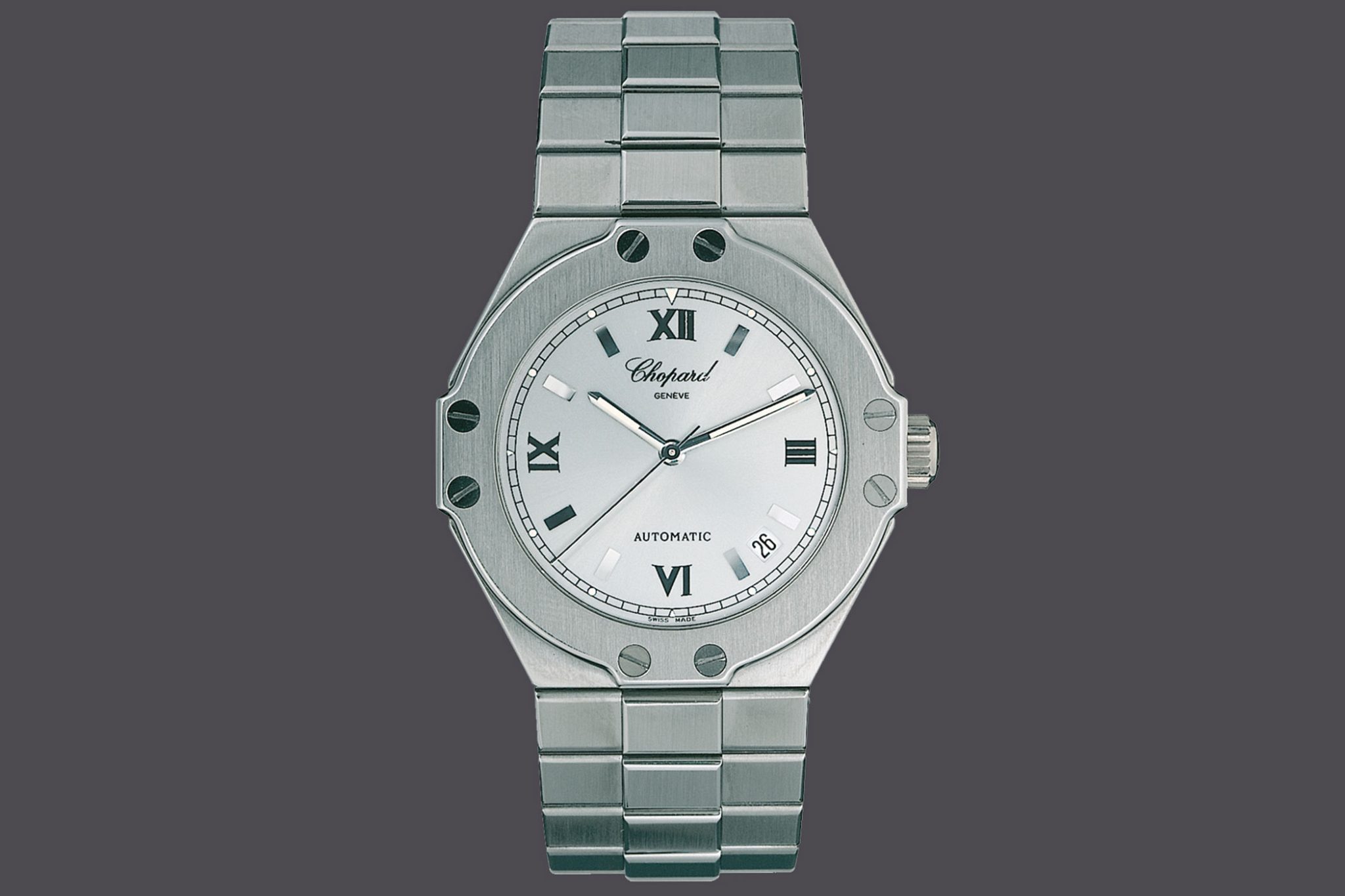
Now Co-President of Chopard, he was a newcomer at the time of the watch’s conception and only 22 years old. His parents had bought the company in the 1960s, and his integration into the brand was commencing – although he would not become vice-president, alongside his sister, until some years later in 1985. His aim for the company’s first steel sports watch followed the Bauhaus principle of ‘form follows function’ (albeit with some embellishments such as the quirky bezel). Following its release at Baselworld in 1980, the watch received a phenomenal 1,000 orders. Although discontinued at a later stage, during its time in action, the St. Moritz lay down a design that would become crucial in the success of today’s collection, which was revived by Scheufele’s son Karl-Fritz.
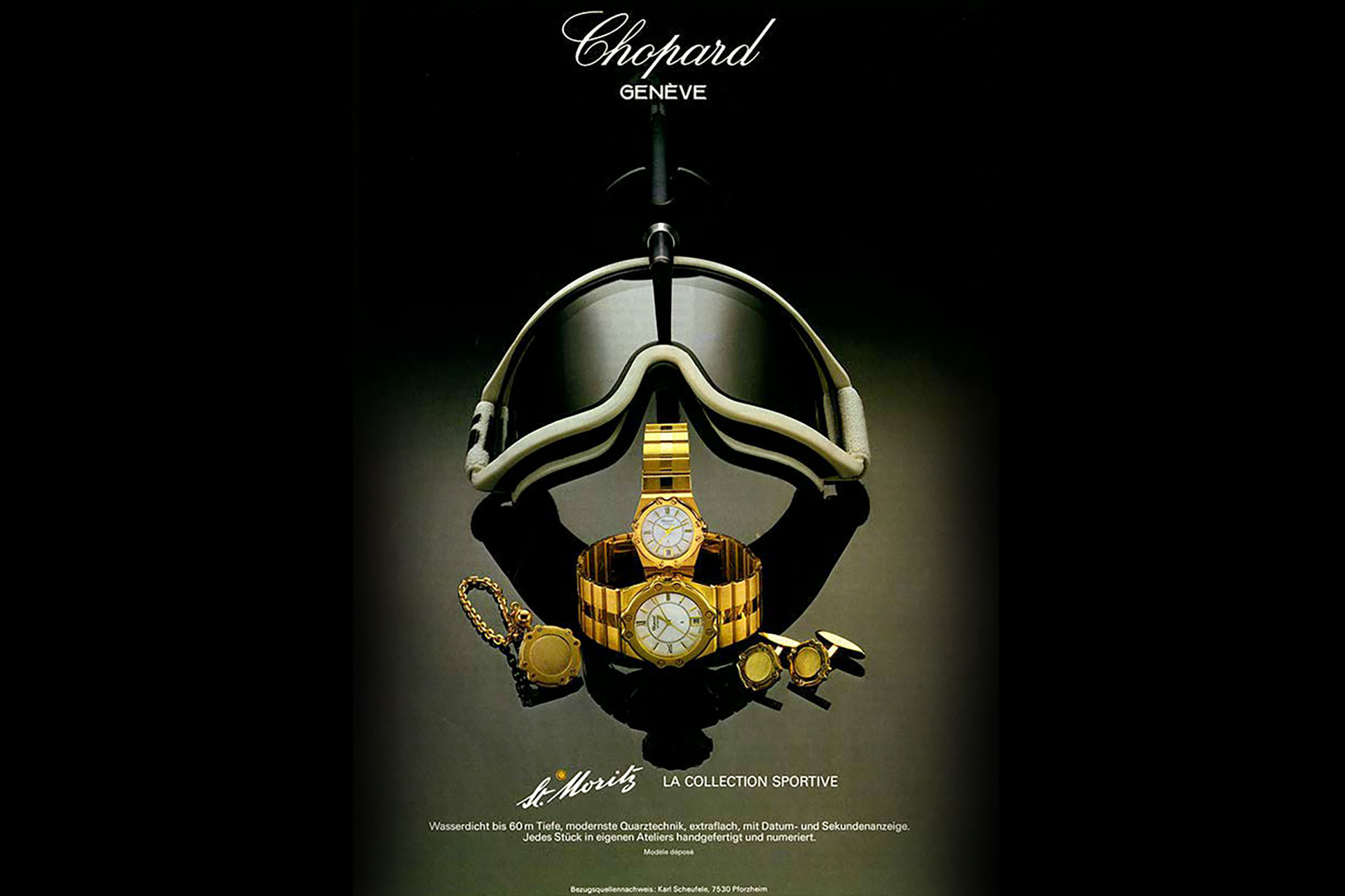
Initially, Karl-Fritz proposed the watch’s revival to his father, who was not enamoured with the idea – “I didn’t say no, I just wasn’t convinced.” However, his grandfather proved to be more supportive – and, when the pair presented the reworked watch a second time, Karl-Fritz’s father, amused by the joining of forces and impressed by the blueprint, was won over. The three-generations agreed to compromise and create something ‘new’ out of it: on the condition that absolutely everyone was happy with the final result. The new design took the absolute best elements of the original watch – exposed screws, raised and complex bezel, plus a sumptuous bracelet – and, with a little help from the addition of a galvanic sunburst dial like no other in watch history, refined these characteristics into a cohesive timepiece with a strong design blueprint and narrative unique to the Chopard manufacture. The family resolved to begin with an annual production of 5,000 pieces per year. When the Alpine Eagle was unveiled, funnily enough, Karl-Fritz was 22, the same age as his father had been when the St. Moritz made its first appearance. Across the generation, things had come full circle. The lesson we can take from the road to the Alpine Eagle is, perhaps, the beauty of self-government. While luxury conglomerates grow ever-stronger and shareholders exert increasing levels of influence at many companies, privately-owned Chopard has the luxury of making all of its decisions at the very heart of the company: in the family.
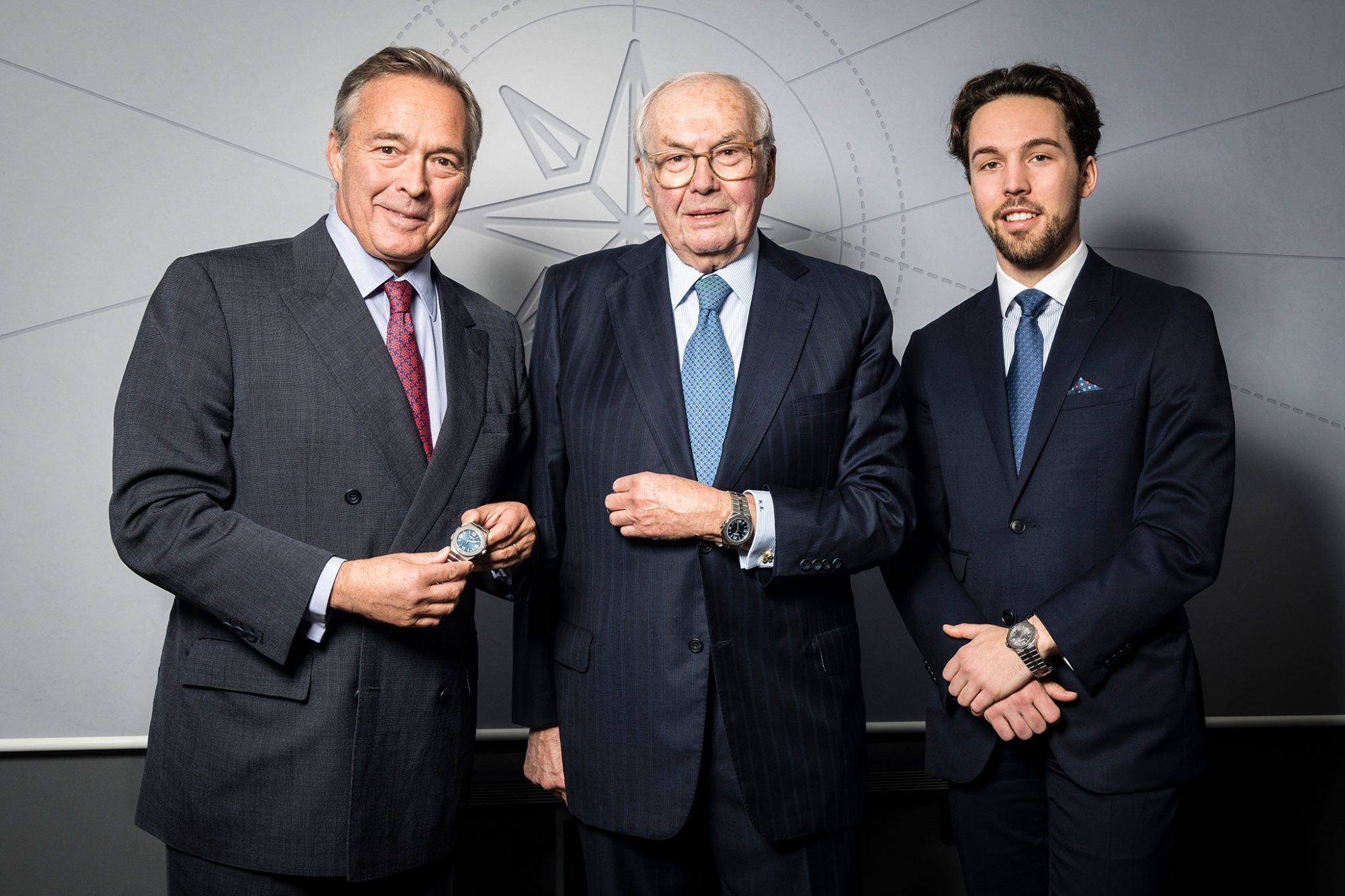
The Alpine Eagle: Materials reflect morals
We can begin our journey into the Alpine Eagle collection by getting to know the materials behind case and bracelet of the Alpine Eagle, which, while varying in terms of dimensions, singularly defines itself through its compact design and second-to-none finishing. As the two most prevalent materials in the main collection, it makes sense to focus upon Lucent Steel and ethical rose-gold. Starting with the word ‘ethical’: Chopard has a pretty good track record when it comes to conscious use of materials – and in my opinion, this is a point well worth appreciating as future generations of watch collectors will likely hold brands with a strong history of environmental awareness in higher regard.
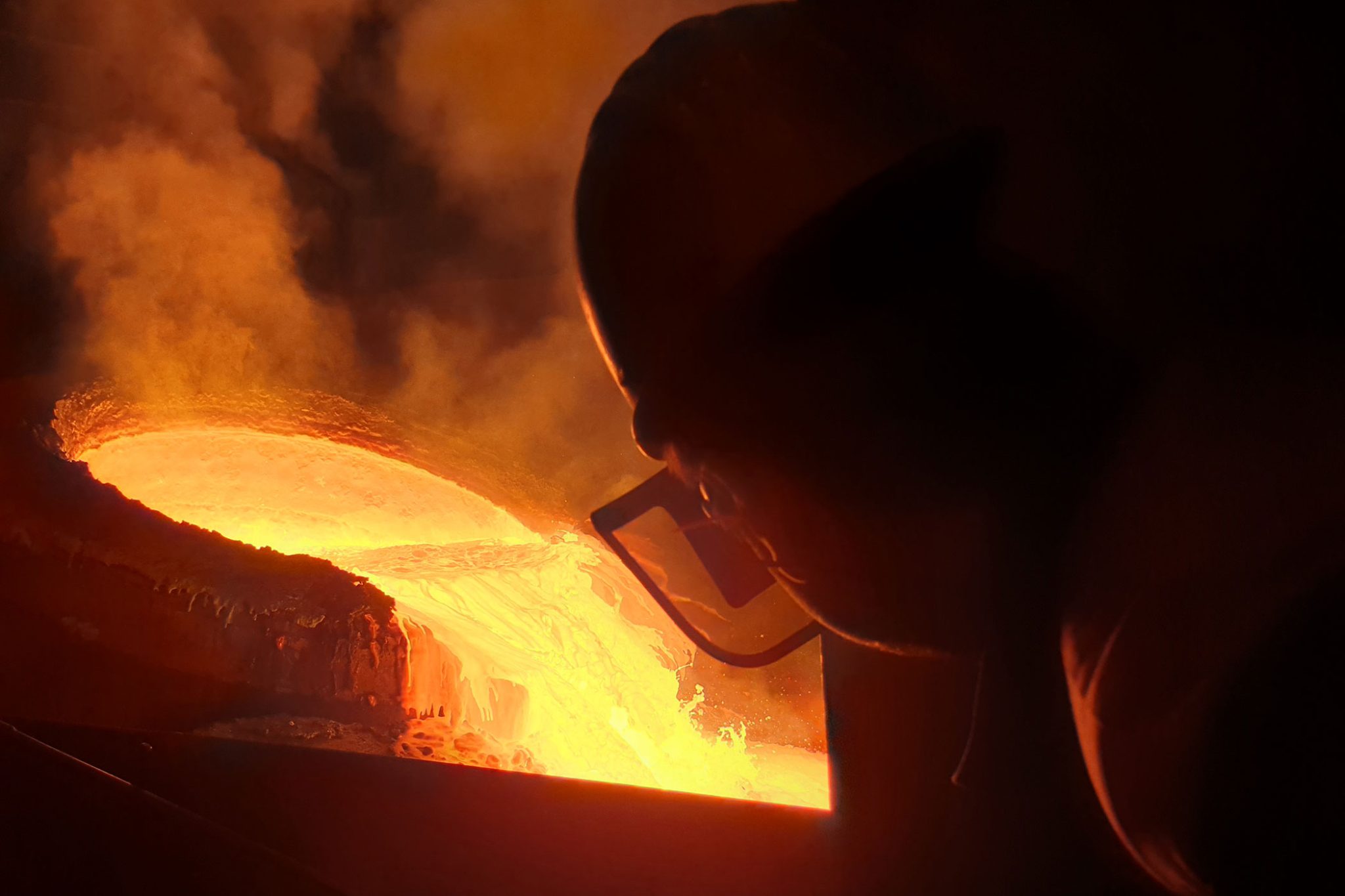
Staying accountable: An industry leader
As mentioned earlier, Chopard is ahead of its time in the watch industry, already introducing its sustainability strategy, christened the ‘Journey to Sustainable Luxury’, over a decade ago. The company has come a long way since then, with the manufacture now executing one of the most commendable approaches to sustainability sourced materials across the luxury sector. Chopard has also led the way in the luxury watch industry by becoming the first to join the Climate Group’s SteelZero initiative, which works along the industry to speed up the transition to a net zero standard steel, and encourage others to implement the same responsible policies.
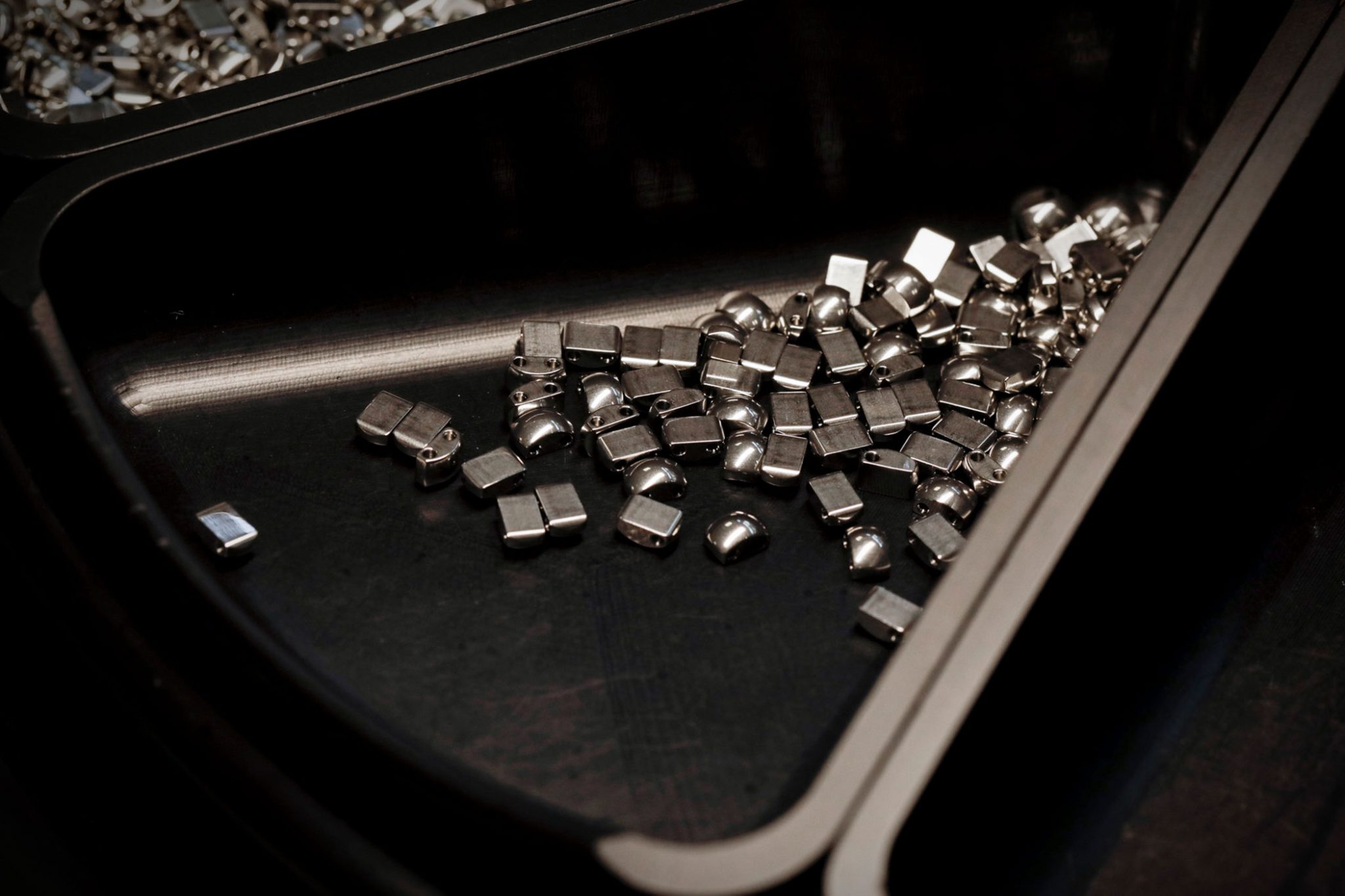
Lucent Steel
For Chopard, the use of sustainable material relates directly to the implementation of vertical integration at the manufacture. The brand has even created its own local circular manufacturing loop: all of its recycled steel suppliers come from within 1,000 km of its manufacturing unit. Any excess scraps from the manufacture are also collected and recycled into new material, thus limiting the extraction of raw materials.
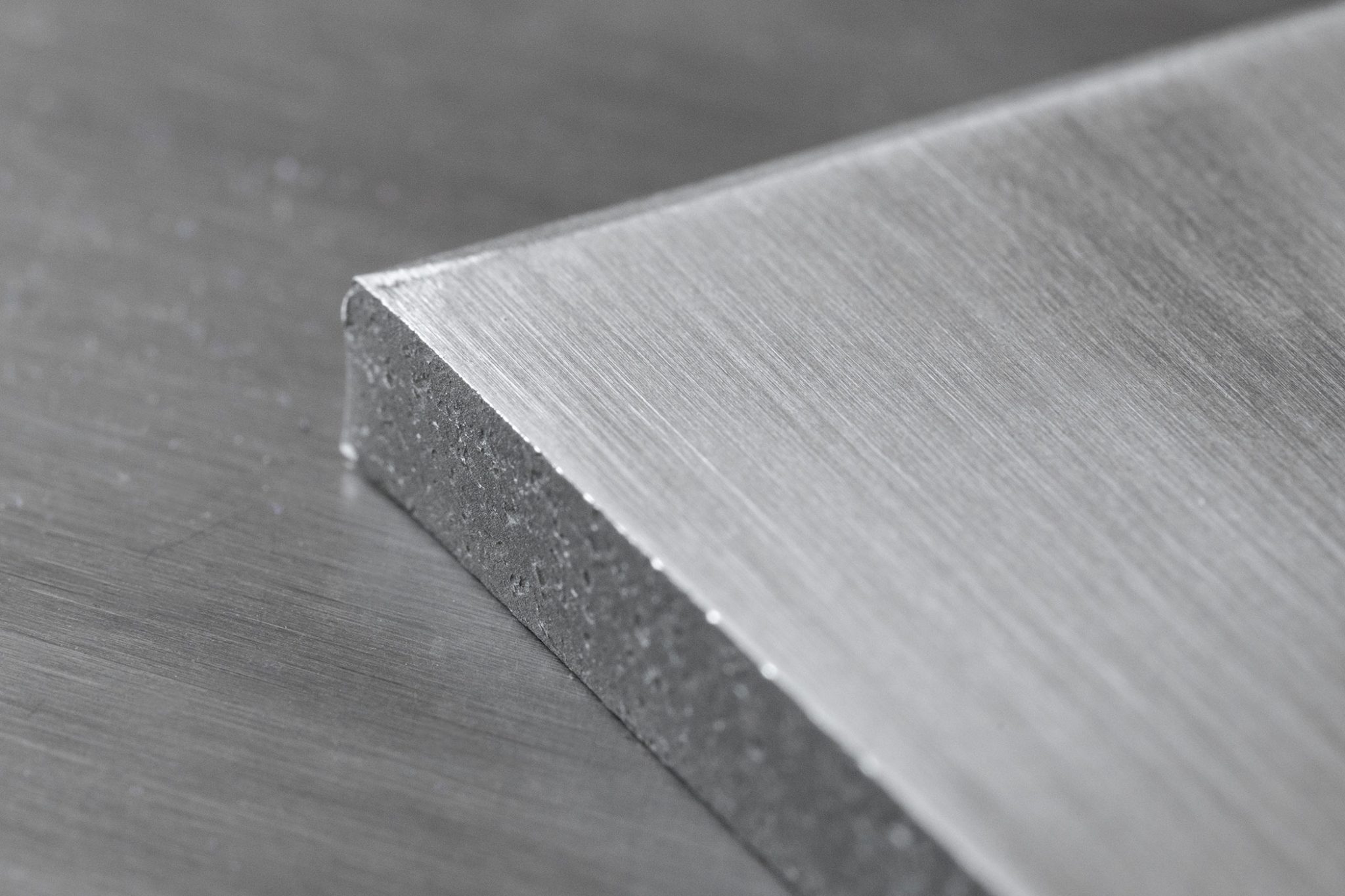
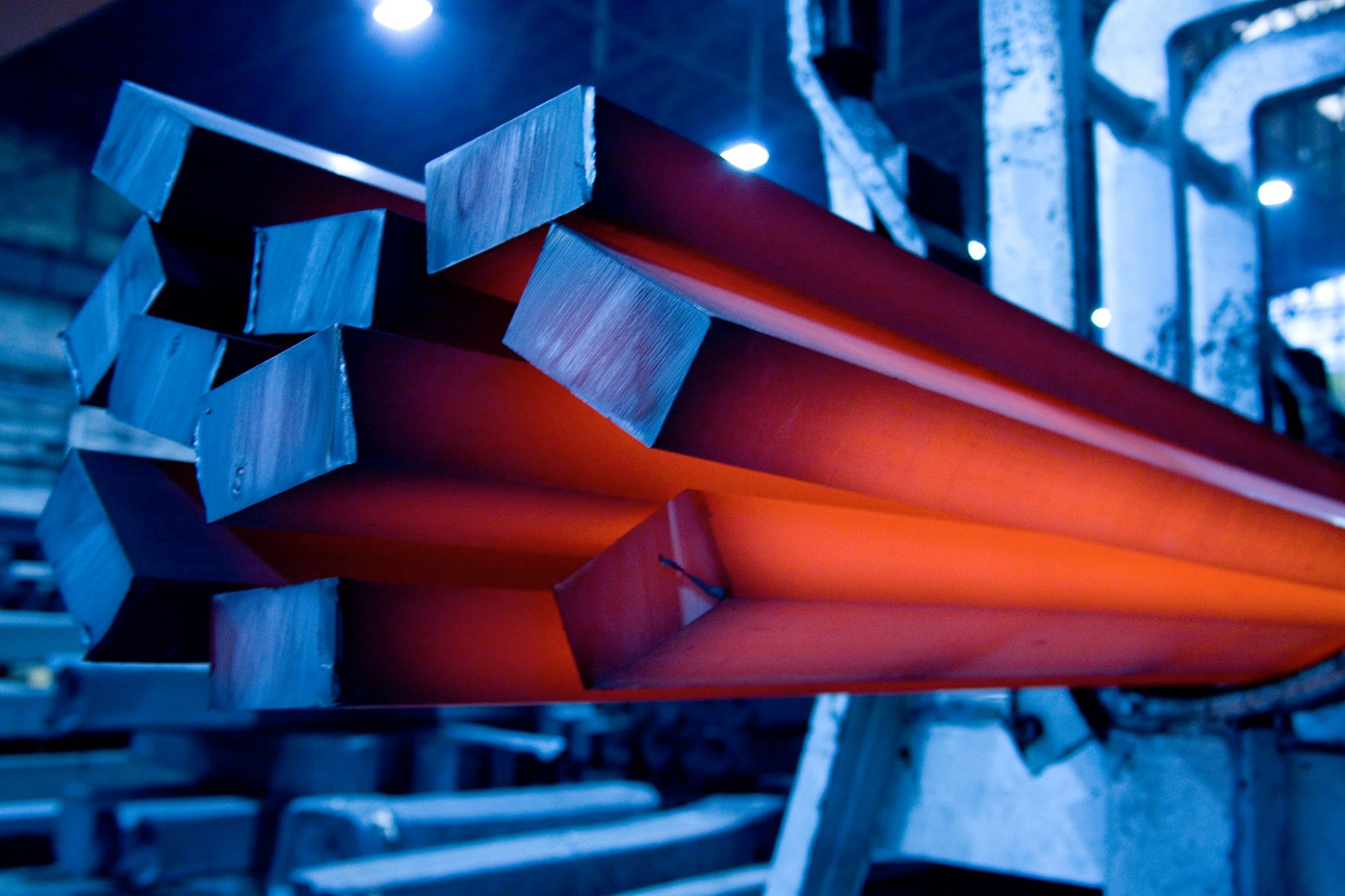
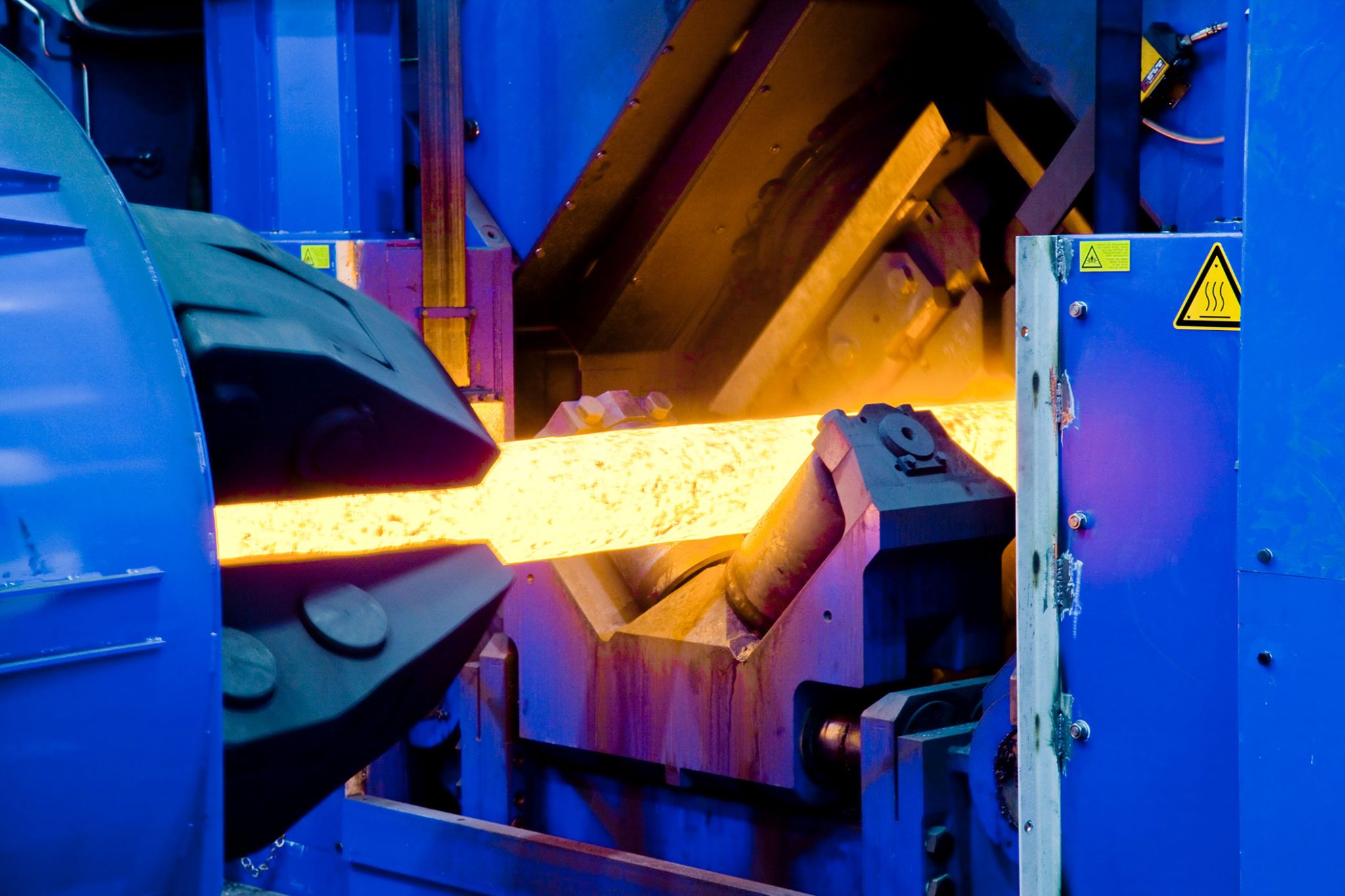
Proof of this can be found in Lucent Steel, which was first launched alongside the Alpine Eagle in 2019. The sporty St. Moritz, by the way, marked Chopard’s first ever use of steel. Lucent Steel doesn’t only tick a box by using at least 80 percent recycled steel, but also by consciously adapting the material, with the help of an Austrian producer, to make it specifically beneficial to a sports watch. The steel alloy is 50 percent harder – up to 223 Vickers, to be precise – than conventional stainless steel, consequently enhancing scratch resistance. Lastly, the highly reflective steel alloy exhibits an extraordinary brilliance, courtesy of its pure composition. In addition, due to the alloy being melted down not once but twice during production, it is able to offer characteristics not dissimilar to surgical steel, thus making it hypoallergic.
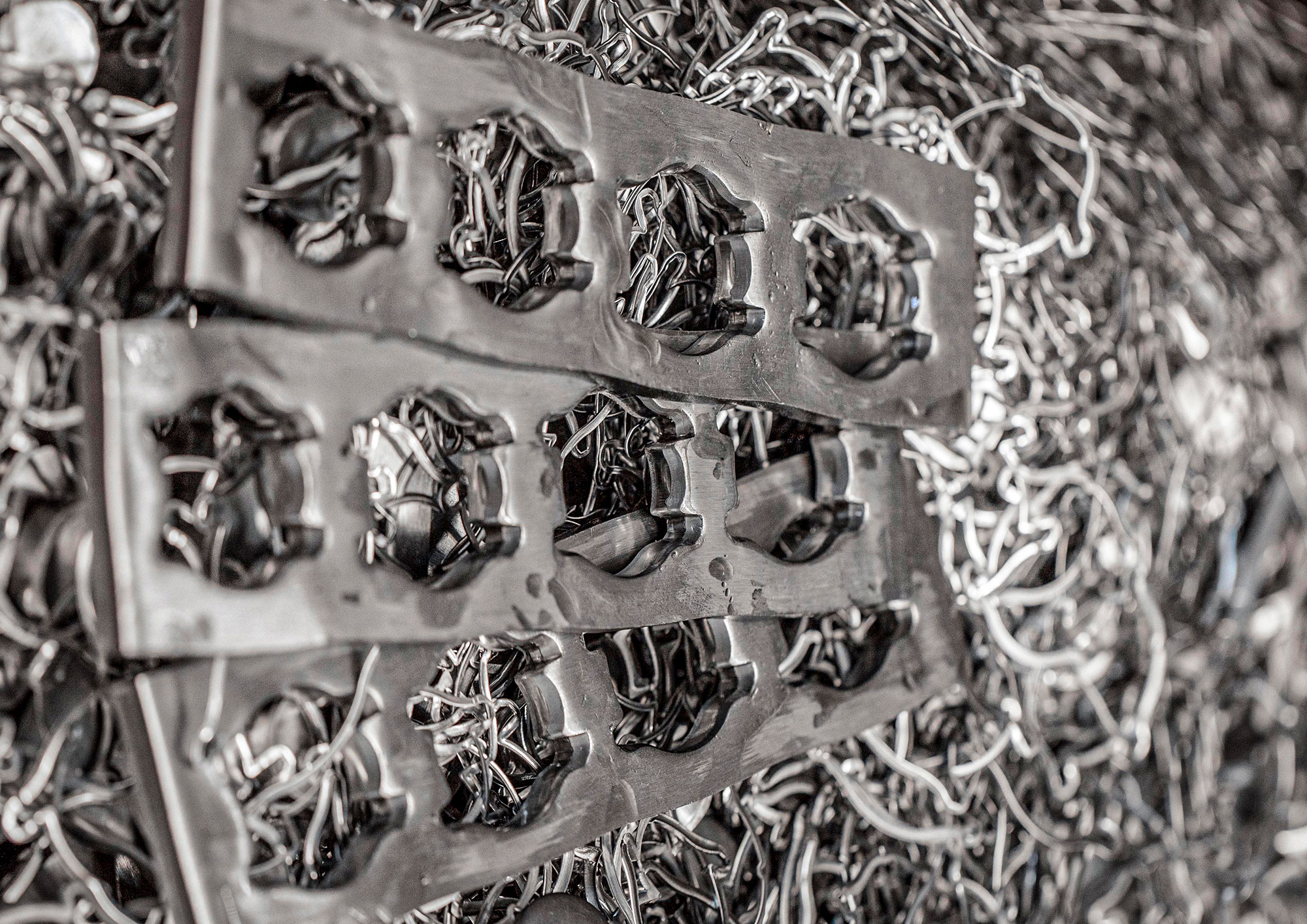
As of the end of 2023, all of Chopard’s watches – not just the Alpine Eagle – have only used Lucent Steel and by 2025, at least 90 percent of said steel will be recycled. The ubiquitous use of the material by the brand is commendable not only environmentally, but also adds credibility to the manufacture by demonstrating its ethical codes, technical know-how, as well as offering a unique selling point.
Going for gold
Meanwhile, the brand’s rose-gold is 100 percent ethically sourced – in fact all of Chopard’s gold, aka the most used material at the manufacture, has been since 2018. As well as meeting its requirements as a member of the ethical Jewellery Council and sourcing its gold through associated traceable schemes, Chopard works exclusively with artisanal mines, making it easier to personally oversee the mining of new gold and ensure traceability from ‘mine to market’ while also supporting local communities. All of the mines participate in either the Swiss Better Gold Association, which focuses upon socially inclusive and improved environmental practices, or the Fairmined Standard, which requires miners to adhere to strict working condition and environmental requirements. Again, these sorts of schemes matter in the luxury sector, and not only in terms of welfare and protection – social and environmental consciousness is also having a powerful effect on the dispelling of common negative conceptions about the luxury industry.
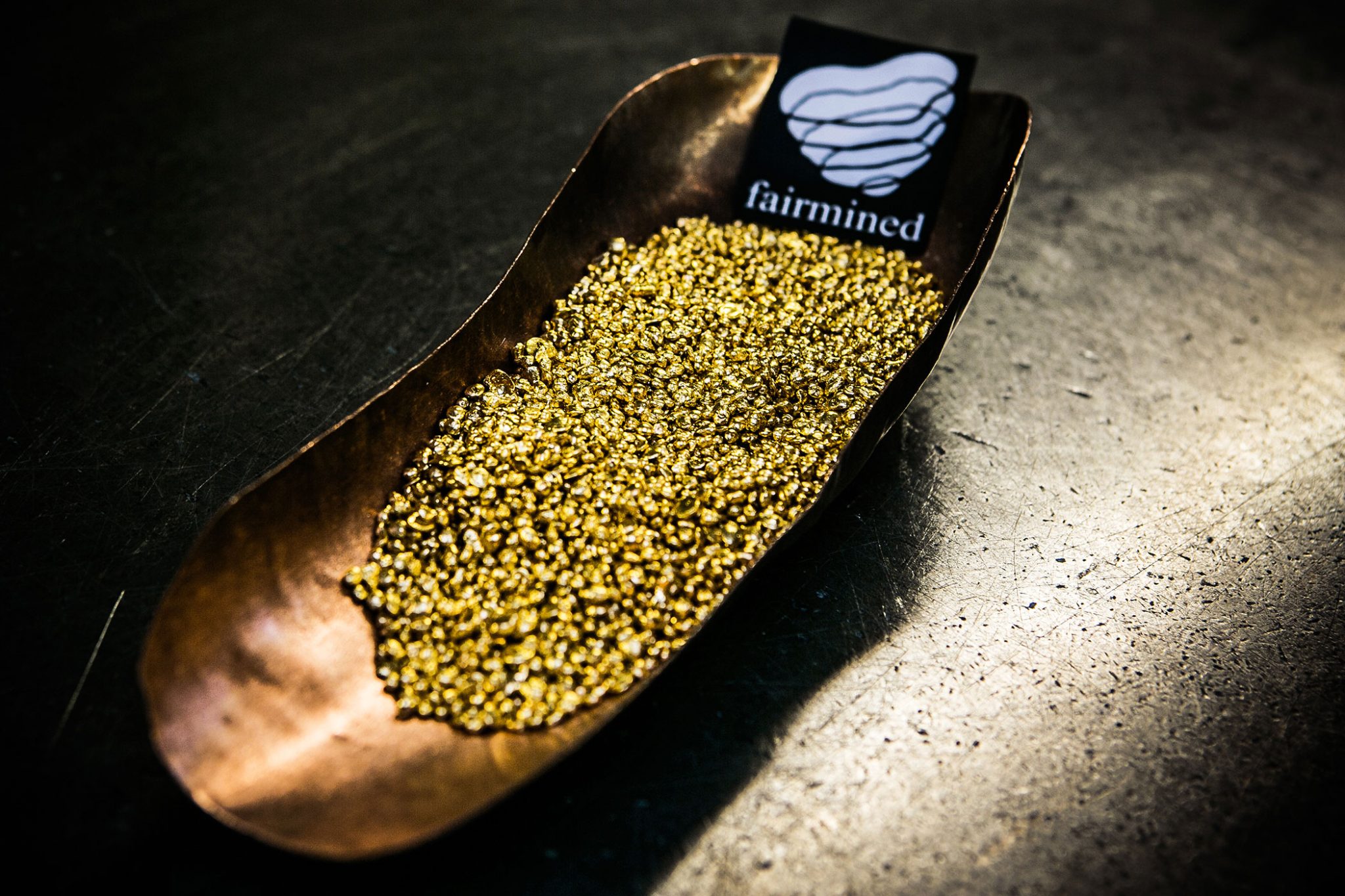
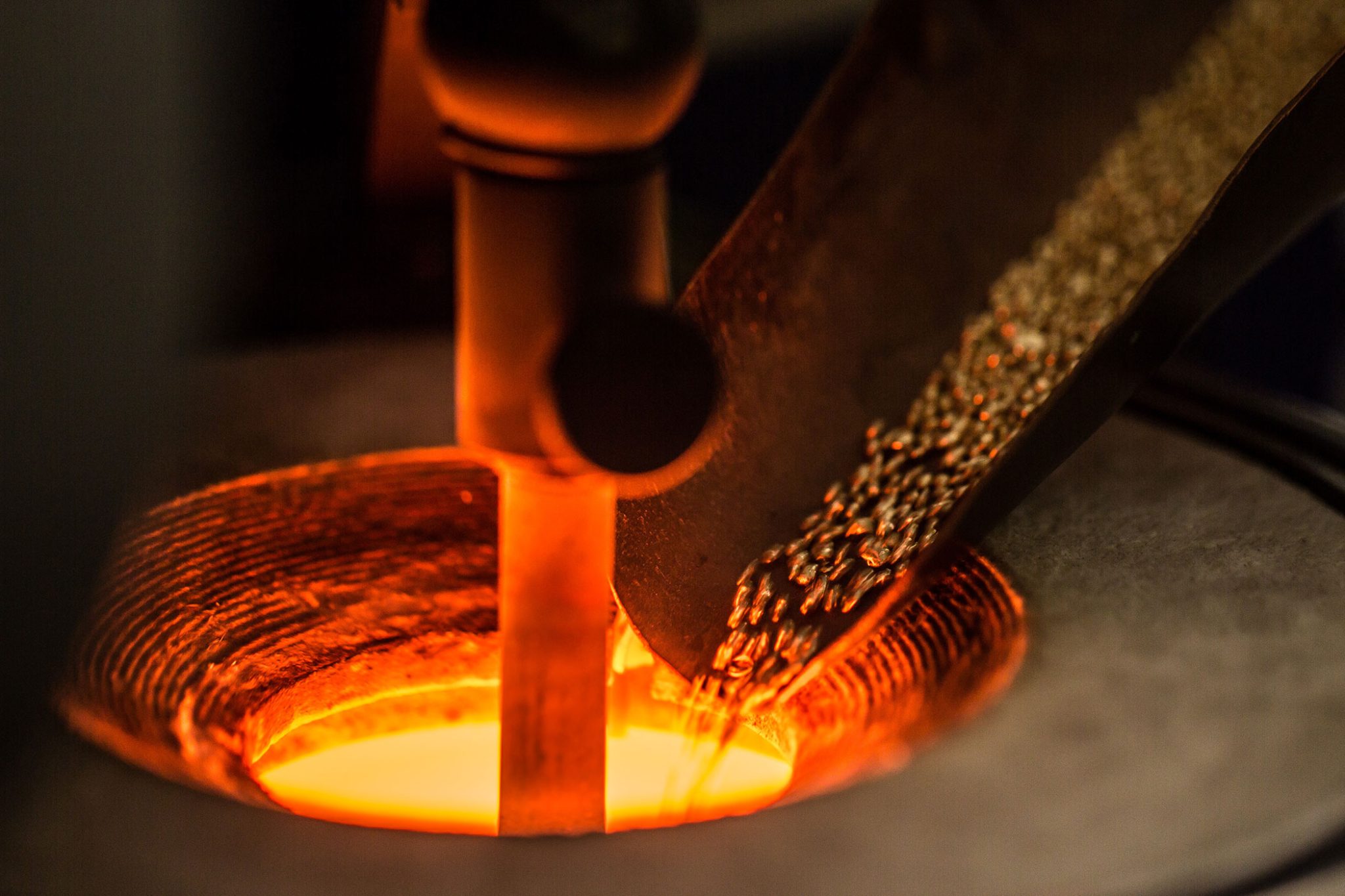

Habillage in-house: The pinnacle of luxury production
Thanks to Chopard’s vertically integrated production process, all of the components – from movement, to case, to bracelet, are all not only produced but also assembled in-house by Chopard’s artisans. This in itself, particularly when it comes to the bracelet, is a rarity, and is made possible thanks to the maison’s highly trained artisans, who play a vital role at Chopard. The maison is home to Fleurisanne Engraving artisans, Master Gemsetting artisans, Grand Complications artisans, Movement Decoration artisans, and even a ‘Dancing Diamonds’ Jewellery and Watch artisan, to name but a few.
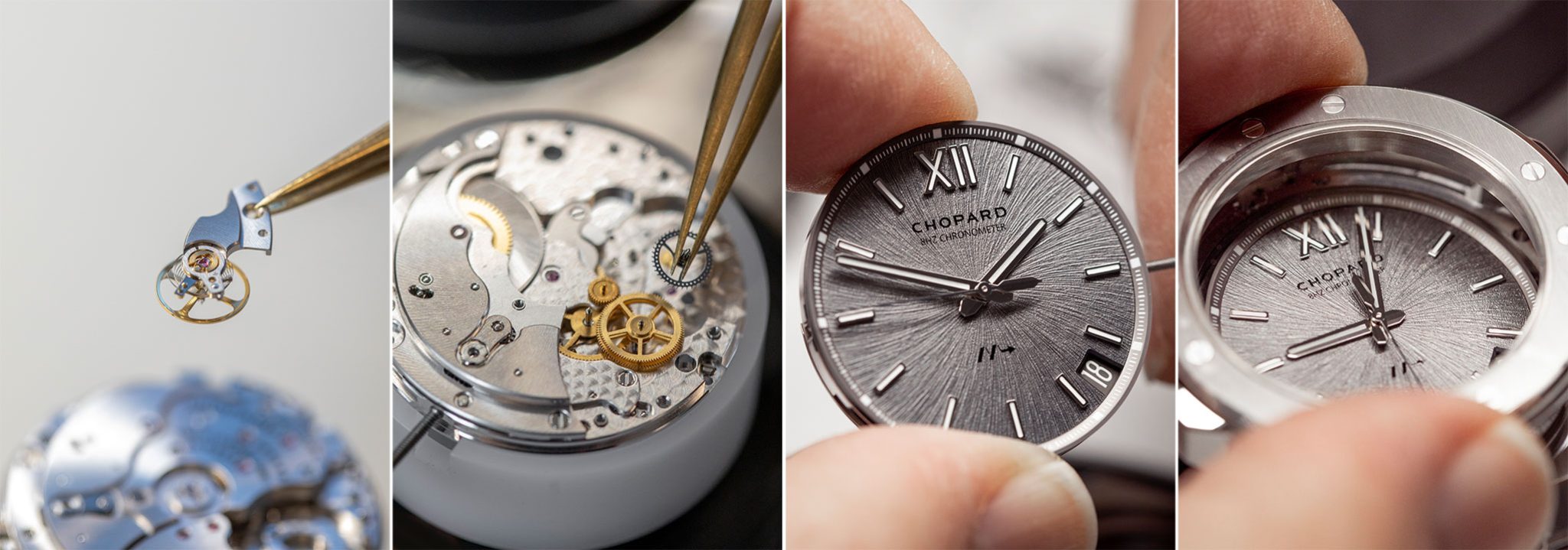
The case and bracelet of any Alpine Eagle deserves an essay in their own right, but let’s keep things to a minimum. In short, few watches in the industry so instantly impress and seduce those who see it as the Alpine Eagle: its case and bracelet collectively embody luxury design, finishing, and execution to an absolute T. Case components, crafted from Lucent Steel, undergo machining on CNC machines using round bars or stamping from flat steel bands.
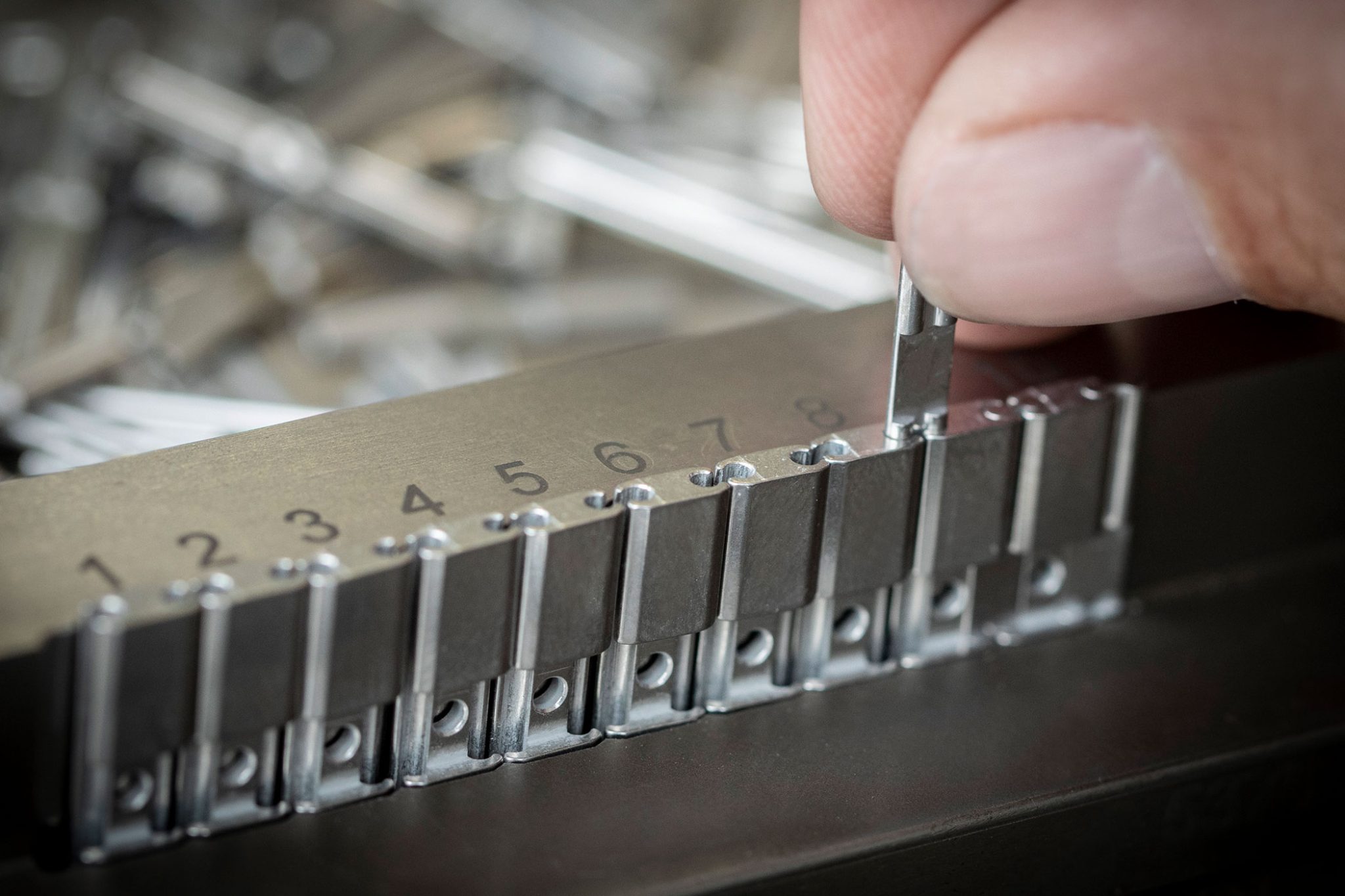
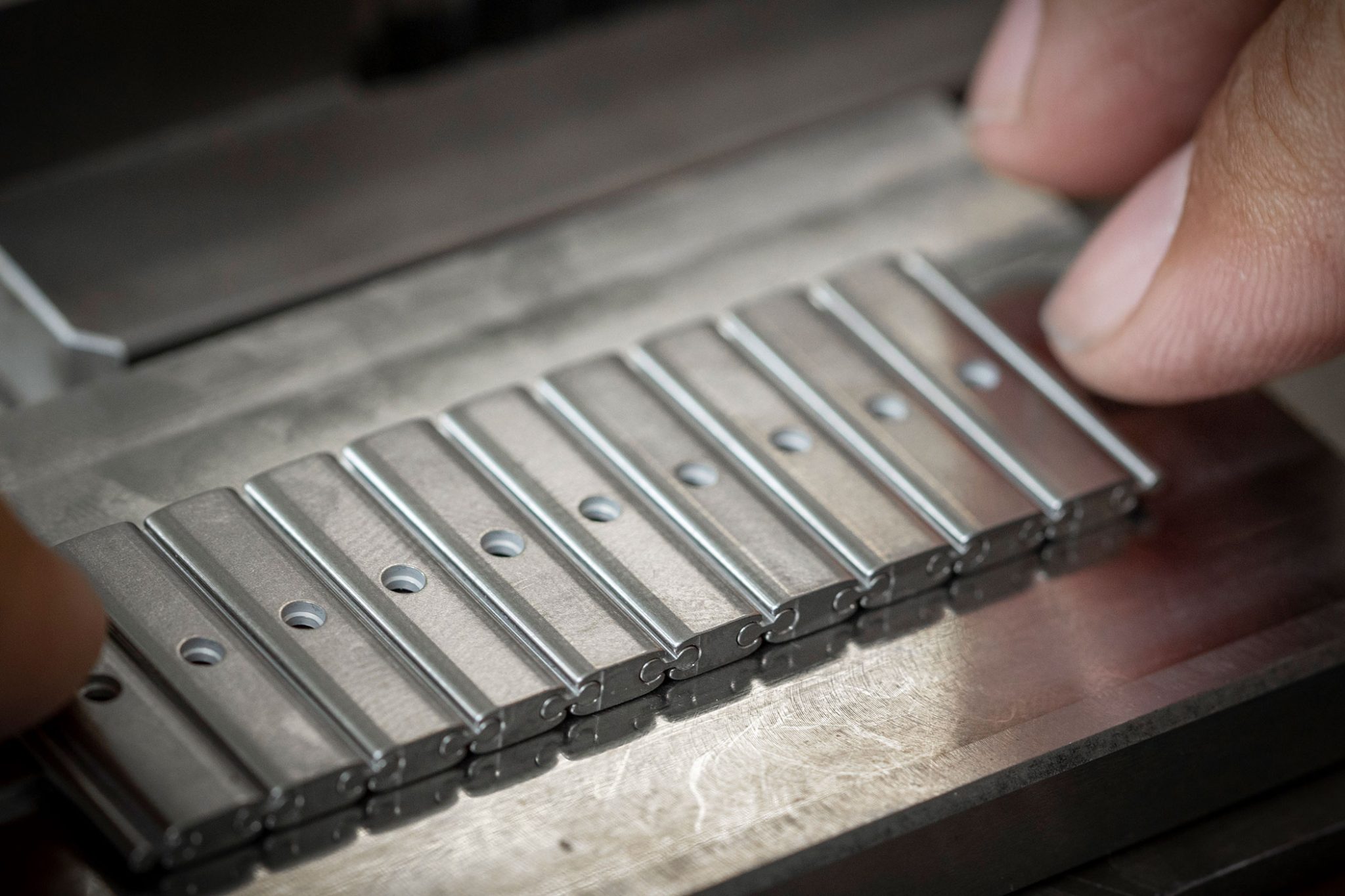
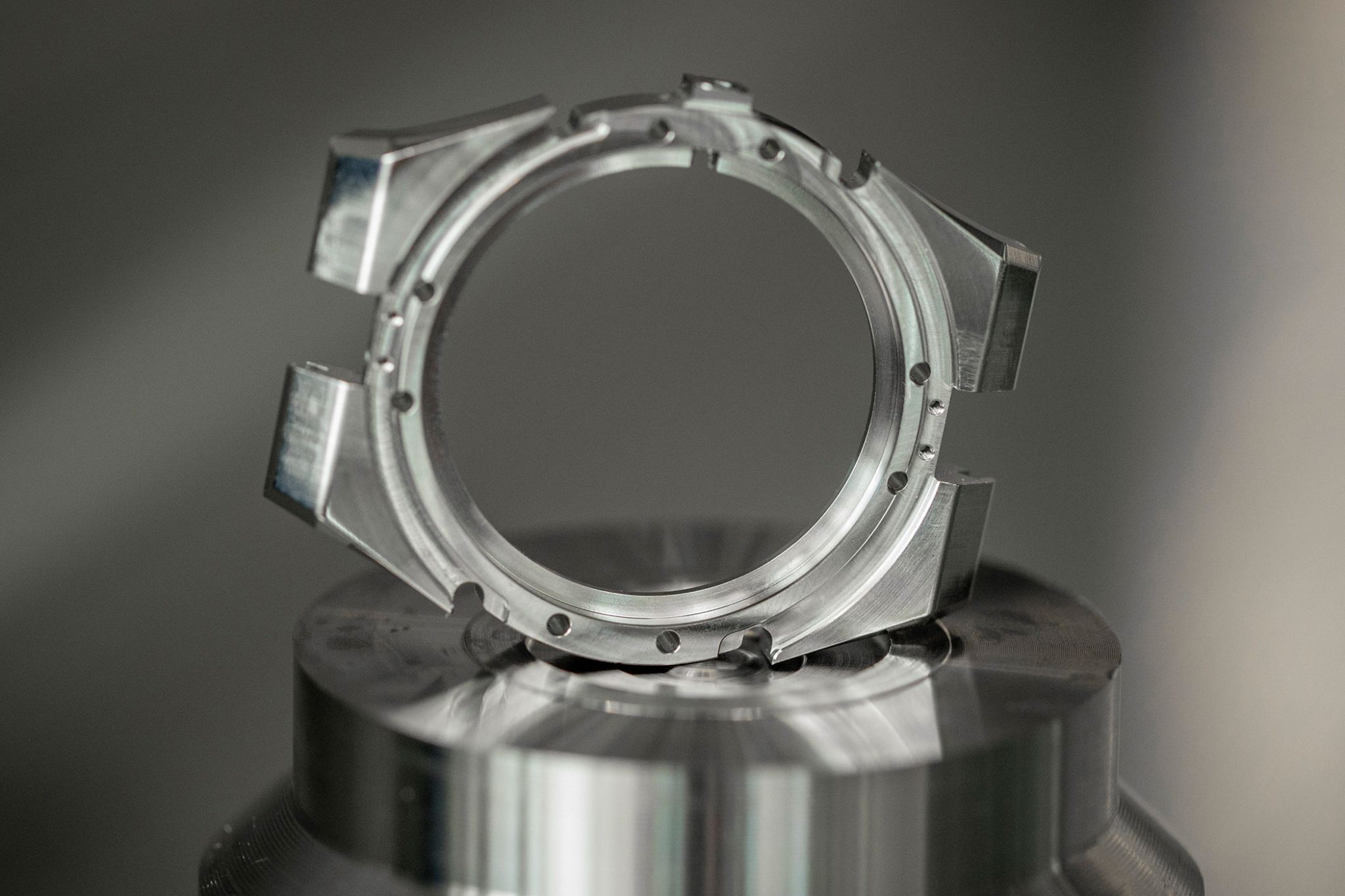
At this point, the artisanal work that helps to create the unrivalled finishing of the sports watches can begin. Craftsmen carefully polish the case and bezel, before skilfully inserting the crown with its rose compass motif and its accompanying components, as well as the flat sapphire crystal. As with any craft, becoming a polishing artisan at Chopard is the result of years of training. Polishing artisans use small lathes and pastes to meticulously reach every tiny corner of the watch and its various components and ensure that no dust, scratches, or rough surfaces are present on the watch, thus achieving the lustre that a luxury Swiss timepiece should exude. Once the equally flawlessly finished bezel has been secured by its eight hallmark screws, the watch can accordingly be tested for water resistance to 100 m.
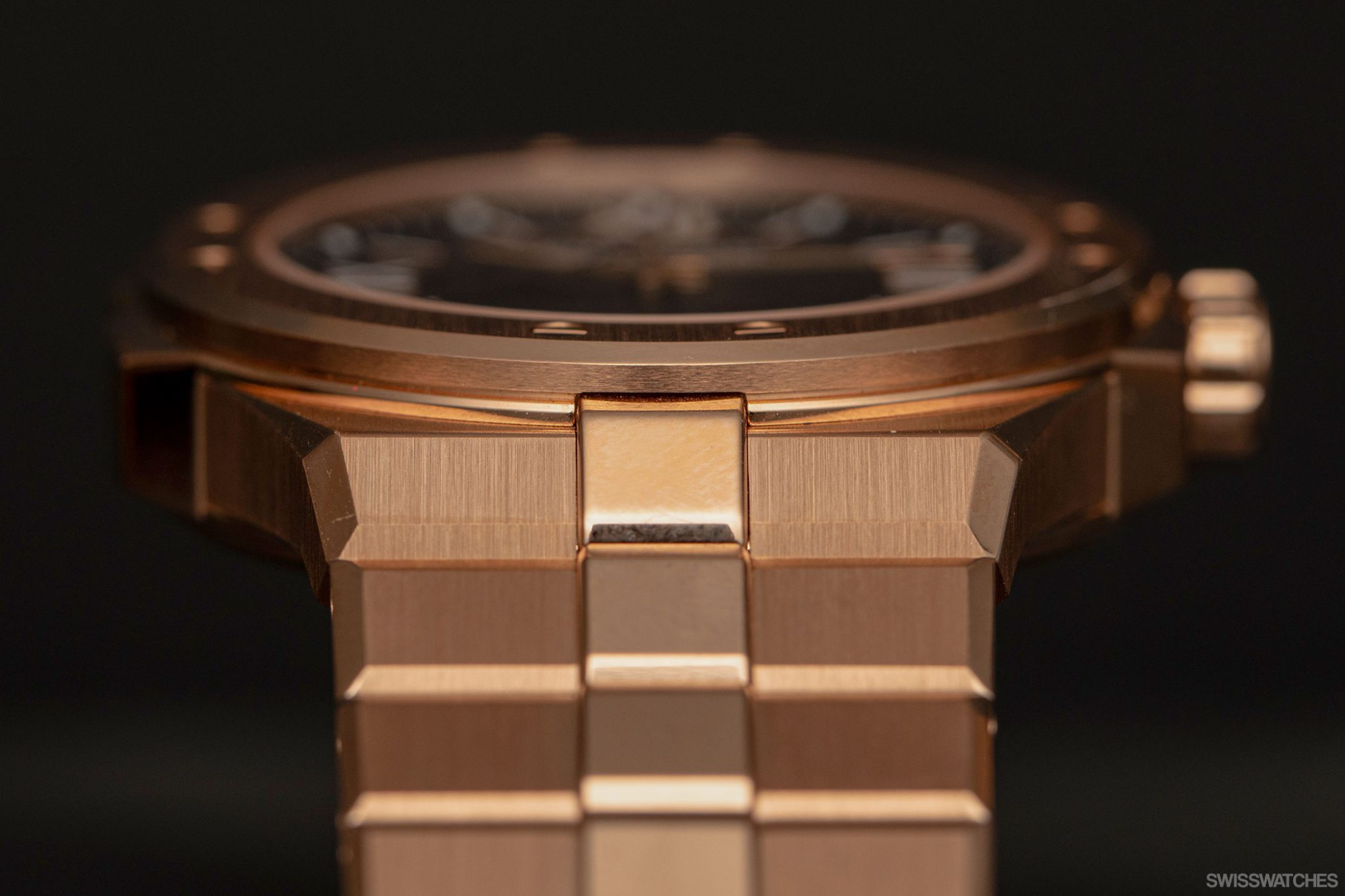
Procuring the integrated tapered bracelet, which comprises a single ingot-shaped link in the middle of each row, topped by a distinctive raised central cap reminiscent of its mountain biotope, is inevitably a less straightforward process. In order to achieve the utmost wearability, each brushed link is slightly graduated in size, making the process yet more arduous. Even before the screws are all put into the bracelet, the links are aligned, faceted, and brushed accordingly, with the measurements of every component fastidiously checked throughout. Only after this process is complete is the distinctive polished square link added in the middle of each row. In my eyes, the brick-like polished link bearing the word ‘Chopard’ on the bracelet clasp is particularly seductive.
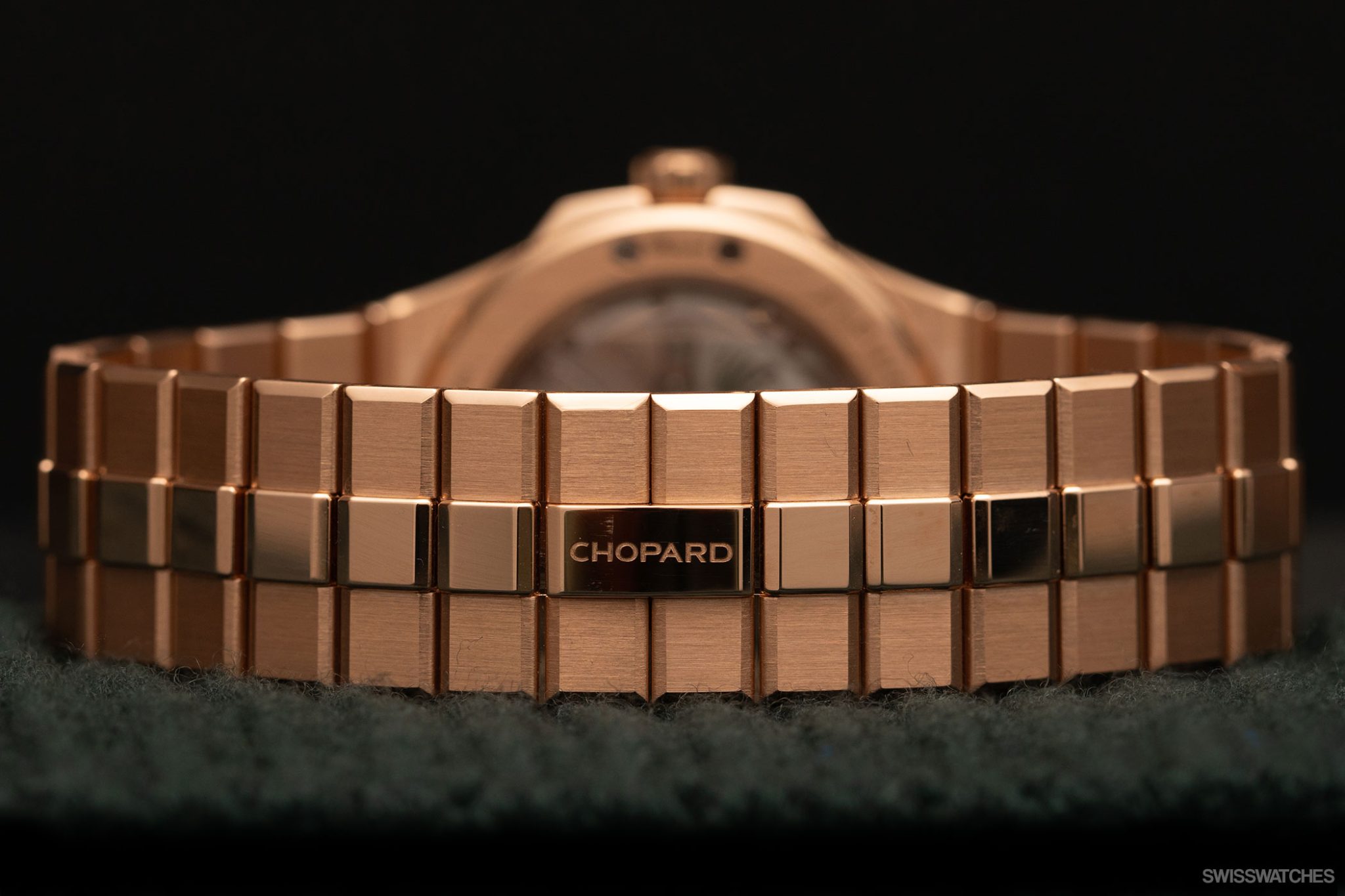
Meet the models: Alpine Eagle with a pine-green dial
The first piece we’ll visit on our quick excursion into the world of Chopard’s luxury sports watch is the Alpine Eagle in Lucent Steel or ethical rose-gold with a Pine Green dial. Chopard’s Alpine Eagle dials stand out due to their unique stamped aesthetic evoking the iris of an eagle’s eye, and come in a range of colours – including several unusual iterations reserved for collectors. Alongside other colours in the current collection, i.e., Aletsch Blue, Bernina Grey and Pitch Black, the Pine Green dial of course draws inspiration from Alpine nature.
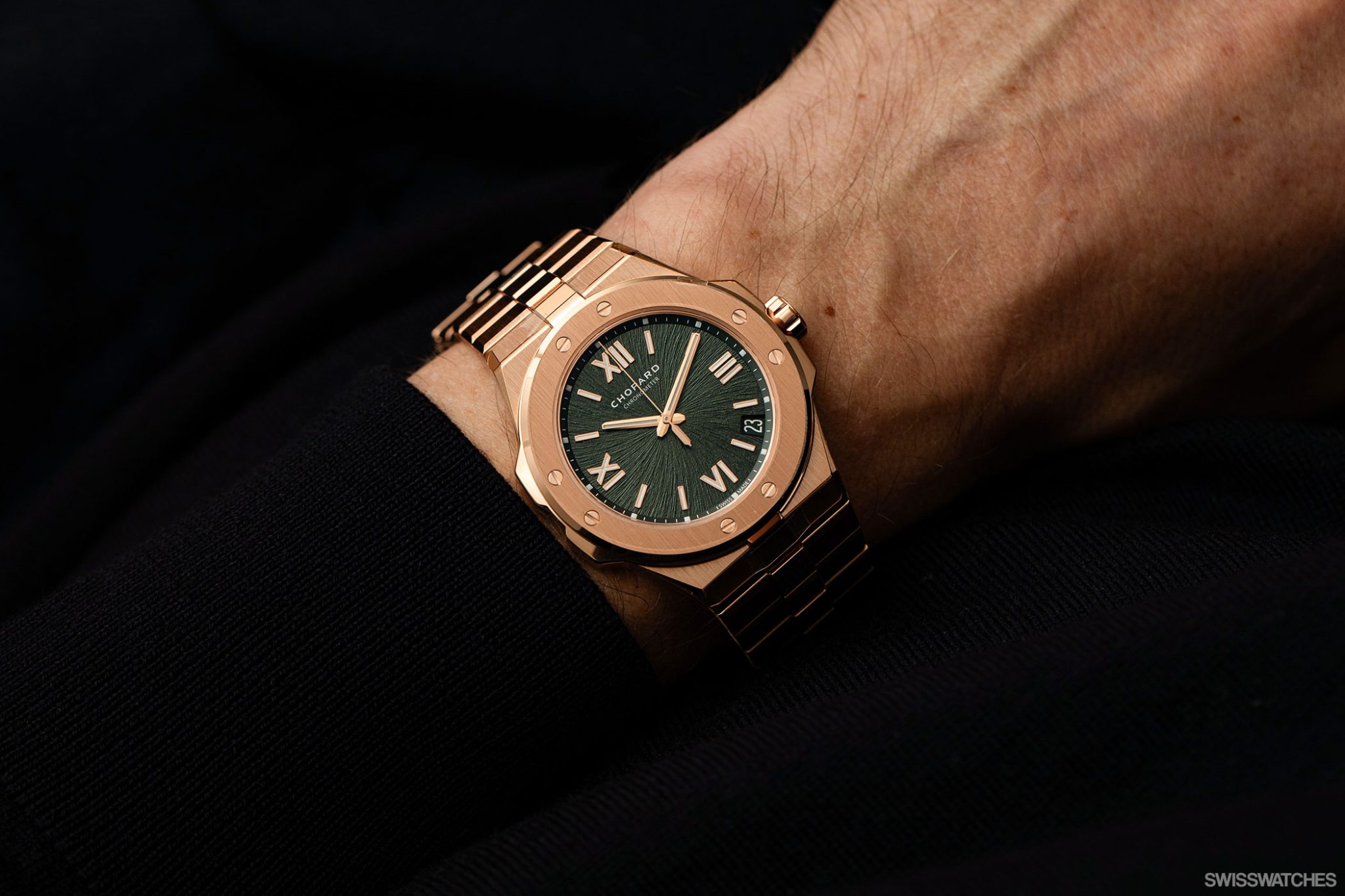
Echoing the St. Moritz, the watches feature a mix of graphic Roman numeral and baton hour markers. While not Arabic (as is more typical for sports watches), the bold hour markers are perfectly executed to indulge in the unapologetically sporty element of the watch’s design, and are further balanced out by the refinement of each and every component. Whatever one’s opinion on the Roman numeral hour markers might be, they also tick the sports watch category in other ways, thanks to a layer of special luminescent named Grade X1 Super-LumiNova, offering 30 percent more brightness than your average lume and degrading slower over time. This same lume is also applied to the rhodium- or gold-plated hands.
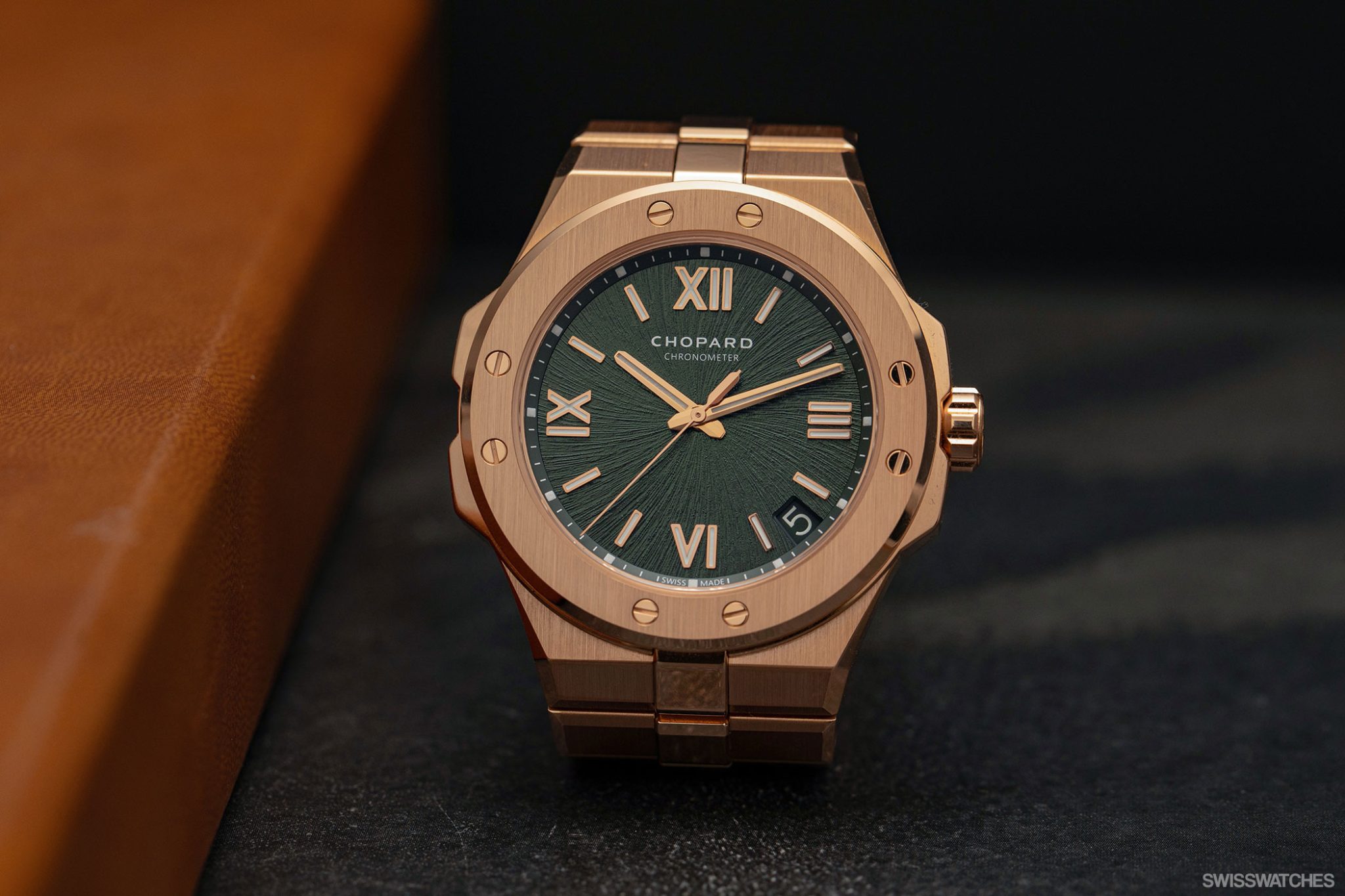
The date is positioned between 4 and 5 o’clock – always a point for discussion amongst collectors. Interestingly, this placement did actually appear on a handful of St. Moritz models, although most appear to have opted for the 6 o’clock position. Meanwhile, in a thoughtful touch, the rhodium-plated seconds hand is (as is the case on all Alpine Eagle watches) in the shape of an eagle feather. Finally, the calibre at play inside this model is the certified chronometer 01.01-C movement. This well-regarded automatic calibre, which consists of 207 components including 31 jewels, has a 60-hour power reserve and beats at a frequency of 4 Hz. Let’s get to know the movement in more detail.
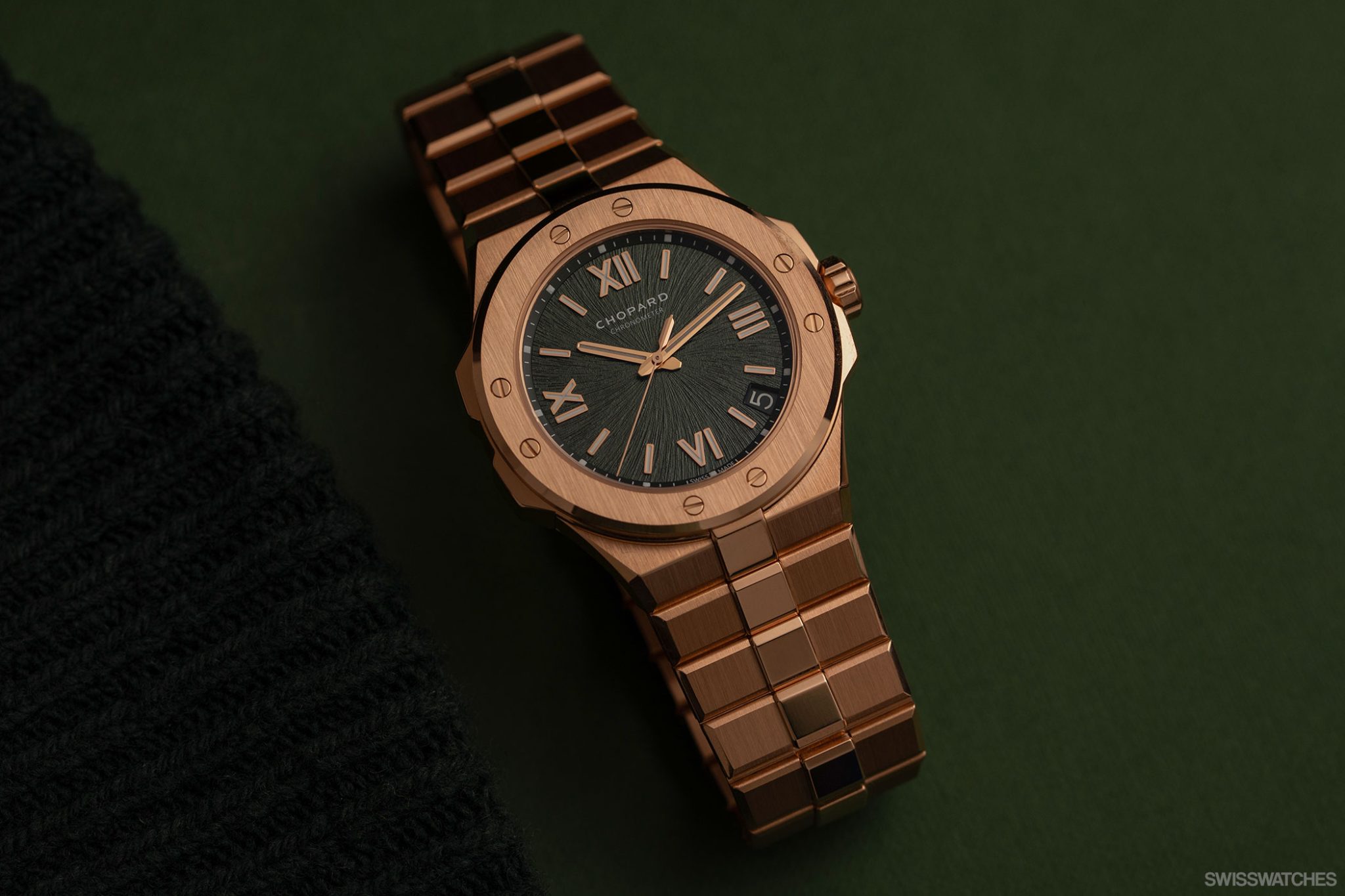
Innovation at Chopard: The advanced manufacturing process behind the calibre 01.01-C
A horological and aesthetic feat in its own right, the calibre 01.01-C, which is created at Chopard’s Fleurier Ebauches site, is housed in Chopard’s 41 mm three-hand Alpine Eagle models. Stand-out features include the partially open-worked oscillating weight with its rich decoration, mirroring the more refined decoration on the components lying beneath it and matching perfectly to the Alpine Eagle’s overall design.
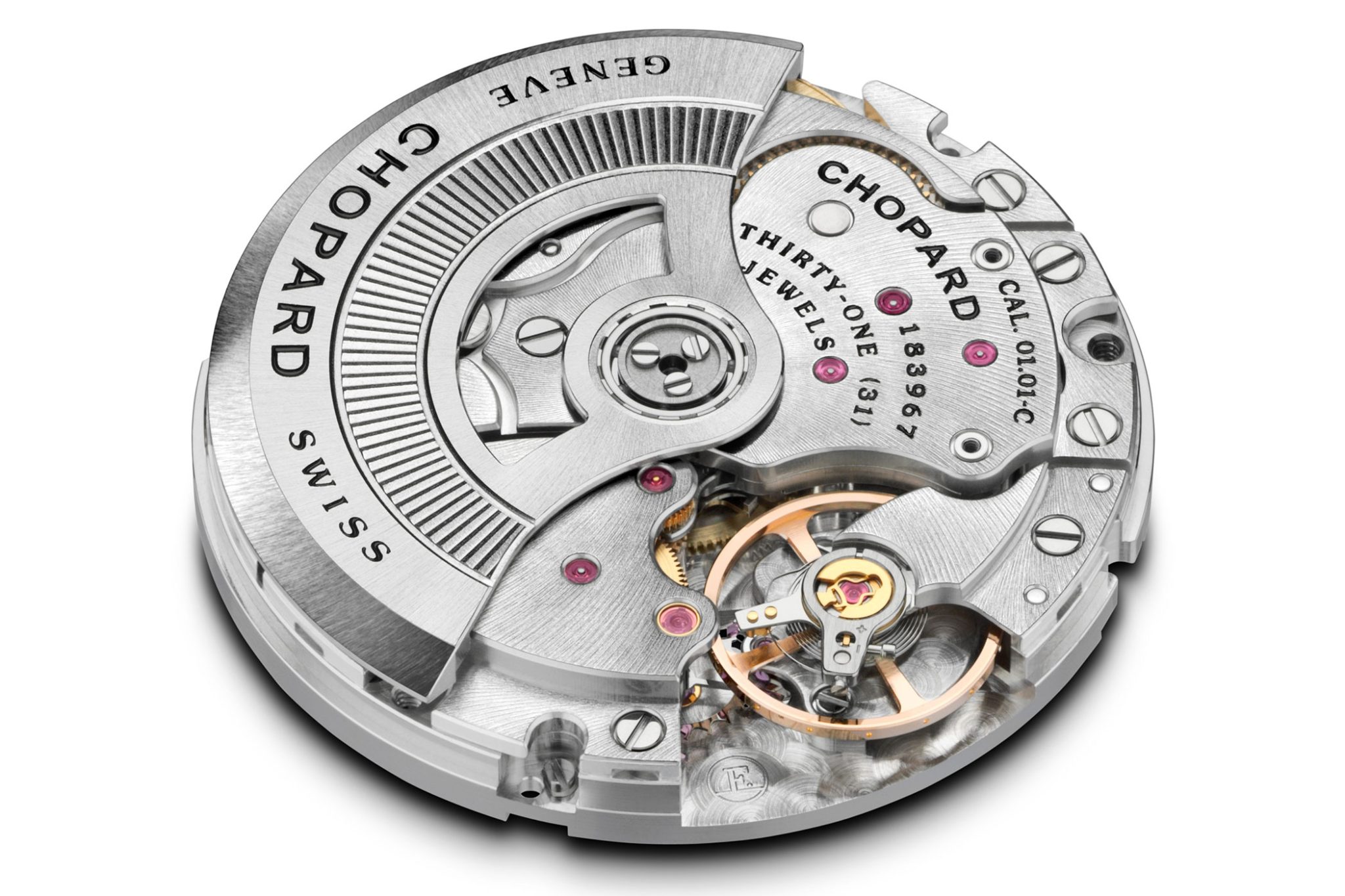
The movement is the living, breathing result of several technical innovations utilised at Fleurier Ebauches. The manufacture uses CNC (Computer Numerical Control) machines for the creation of its bridges and the brass mainplate, with the machines carefully programmed by experts to cut and drill the components into a single brass plate. The components are then checked with a micrometre in order to ensure that every single element is in the exact right position – the slightest deviation could result in imprecision across the board. Fleurier Ebauches also invested in several other high-tech machines, including a spark erosion machine (for steel components) and profile turning machines (responsible for producing the smallest components such as pinions, screws). Once again, use of the machines requires absolute expert knowledge and the utmost meticulousness – in fact, the programming of the machines often takes longer than the execution.
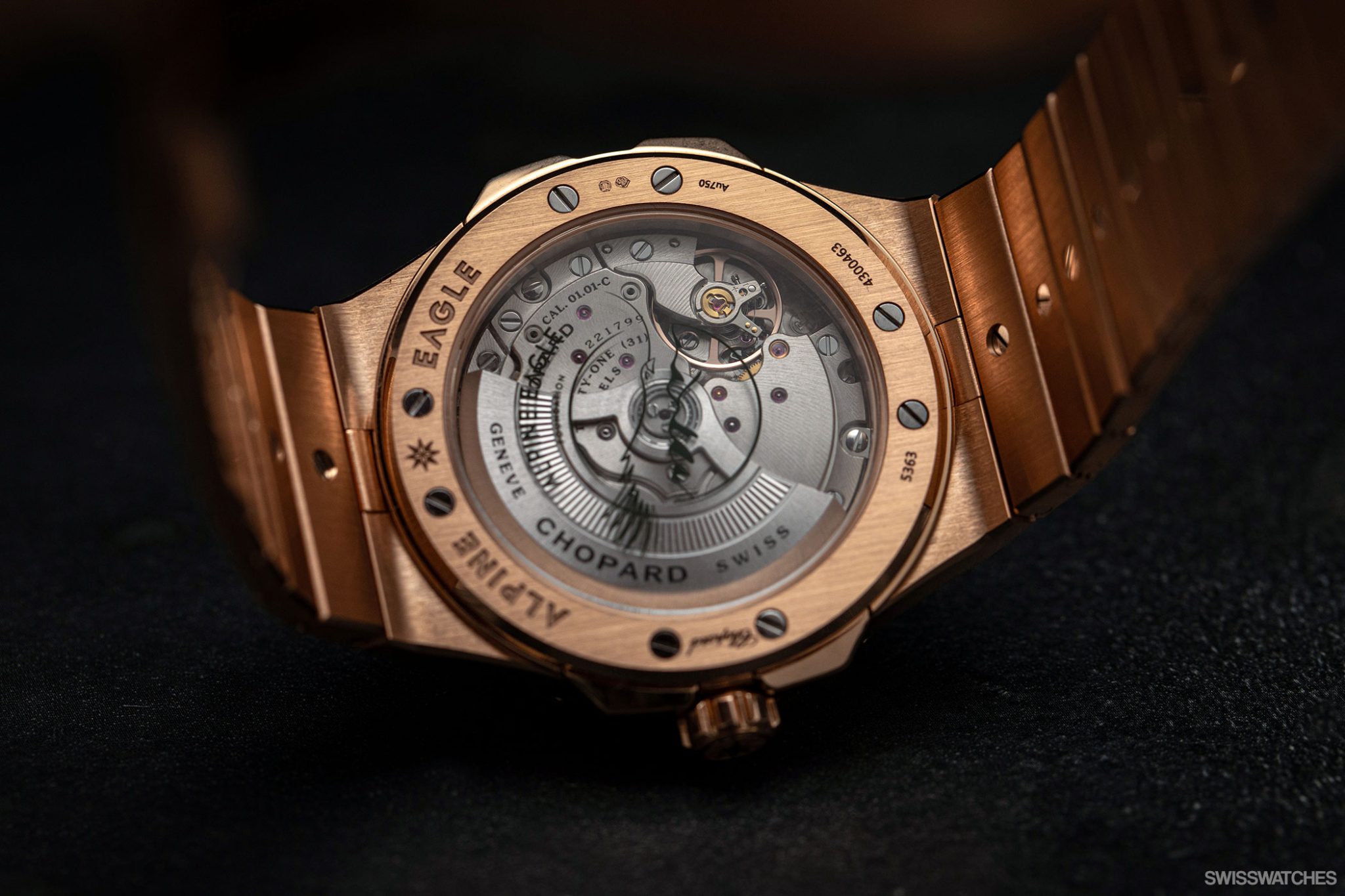
Following this process, the 01.01-C can be worked on to produce the aforementioned decoration that so defines the movement. While the bridges feature a colimaçon (spiral) finishing, the finely decorated mainplate showcases the overlapping so-called perlage finishing – although it should be pointed out that in the case of this oft-used movement, the decoration is achieved through means of a machine, not by hand. Only the finest movements employed in certain collections and exclusive pieces, e.g. all the L.U.C models, are done by hand. Meanwhile, the machined decoration on the Alpine Eagle’s calibre emanates a smarter rather than artisanal look. Whether this is something to be preferred is simply down to a matter of a collector’s taste – and, in any case, it prevents the price of the watch being driven up. Nevertheless, no component is left untouched: each bridge sports a bevel on the leading edge, while every miniature screw is chamfered around the edges.
Of course, once the movement has been assembled, it is thoroughly tested before heading to Contrôle Officiel Suisse des Chronomètres (COSC). On site at Fleurier Ebauches, watchmakers check the likes of the calibre’s rate accuracy and beat, while COSC goes on to conduct further tests for the next two weeks. The Alpine Eagle movement is tested at several different temperatures (let’s remember, this is a watch that takes its inspiration from Europe’s most formidable mountain range) and in a good five varying positions. All of these factors lead to the words ‘Chronometer’ being proudly stamped on the Alpine Eagle’s dial directly beneath the Chopard logo.
Alpine Eagle XL Chrono in Lucent Steel
Having touched upon three-hand models, it’s worth taking a look at one of the collection’s most important complicated models, aka the Alpine Eagle XL Chrono in Lucent Steel. A couple of particularly handsome models are the duo of Chopard Alpine Eagle watches featuring an Aletsch Blue or Pitch Black dial from 2020. The XL quickly won hearts for its inclusion of a flyback chronograph, integrating a handsome hour subdial counter as well as a semi-instantaneous 30-minute counter that had plenty of Chopard fans excited. Thanks to its 44 mm case diameter contrasting finishing, and subtle aesthetic details, there’s no way one could critique the legibility on this chronos. There’s no doubt that the sports watches best suit those with a more sizeable wrist – but thanks to the integrated bracelet or rubber strap, it is possible for the watch to work on slightly slimmer wrists, too.
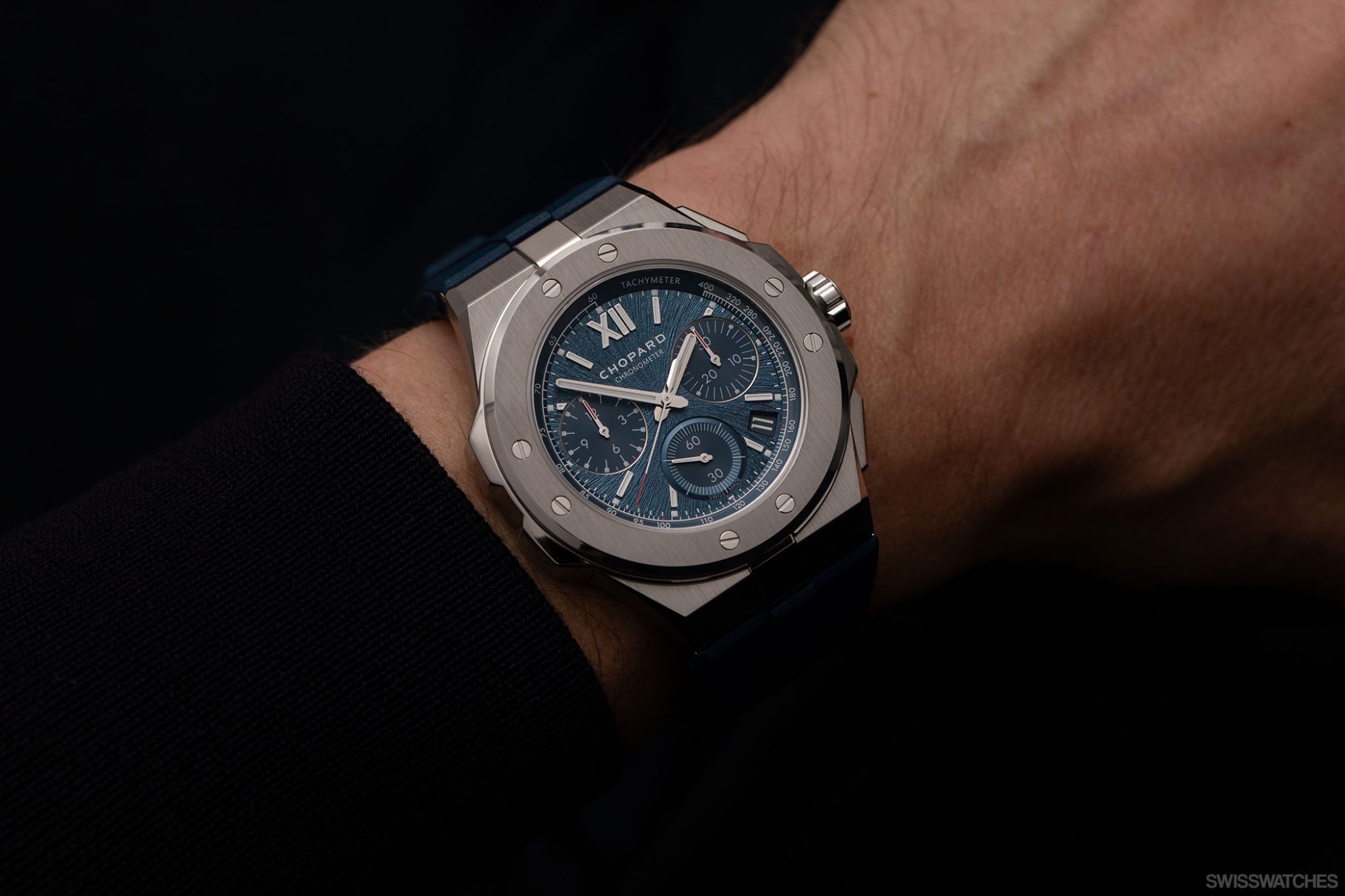
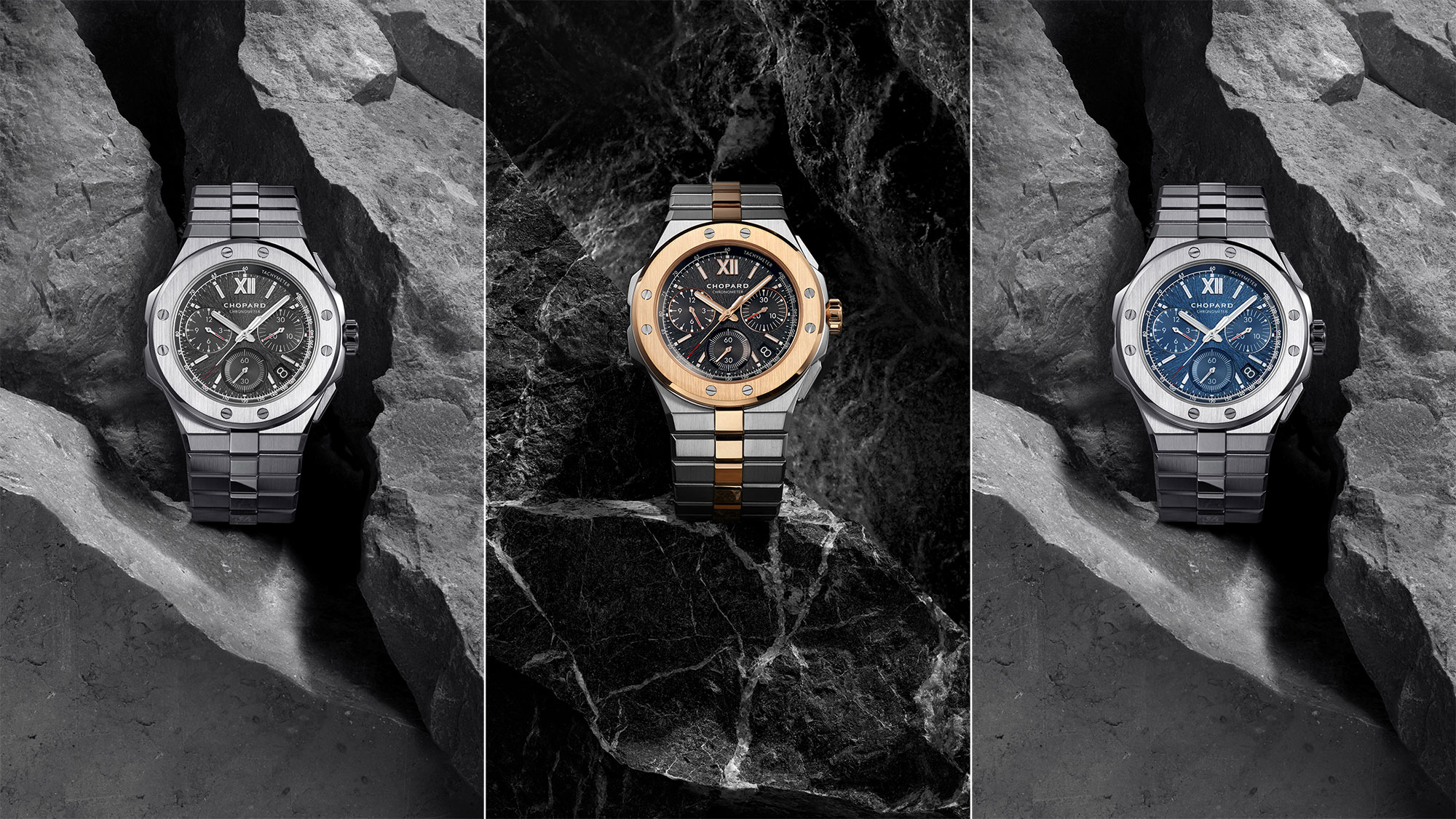
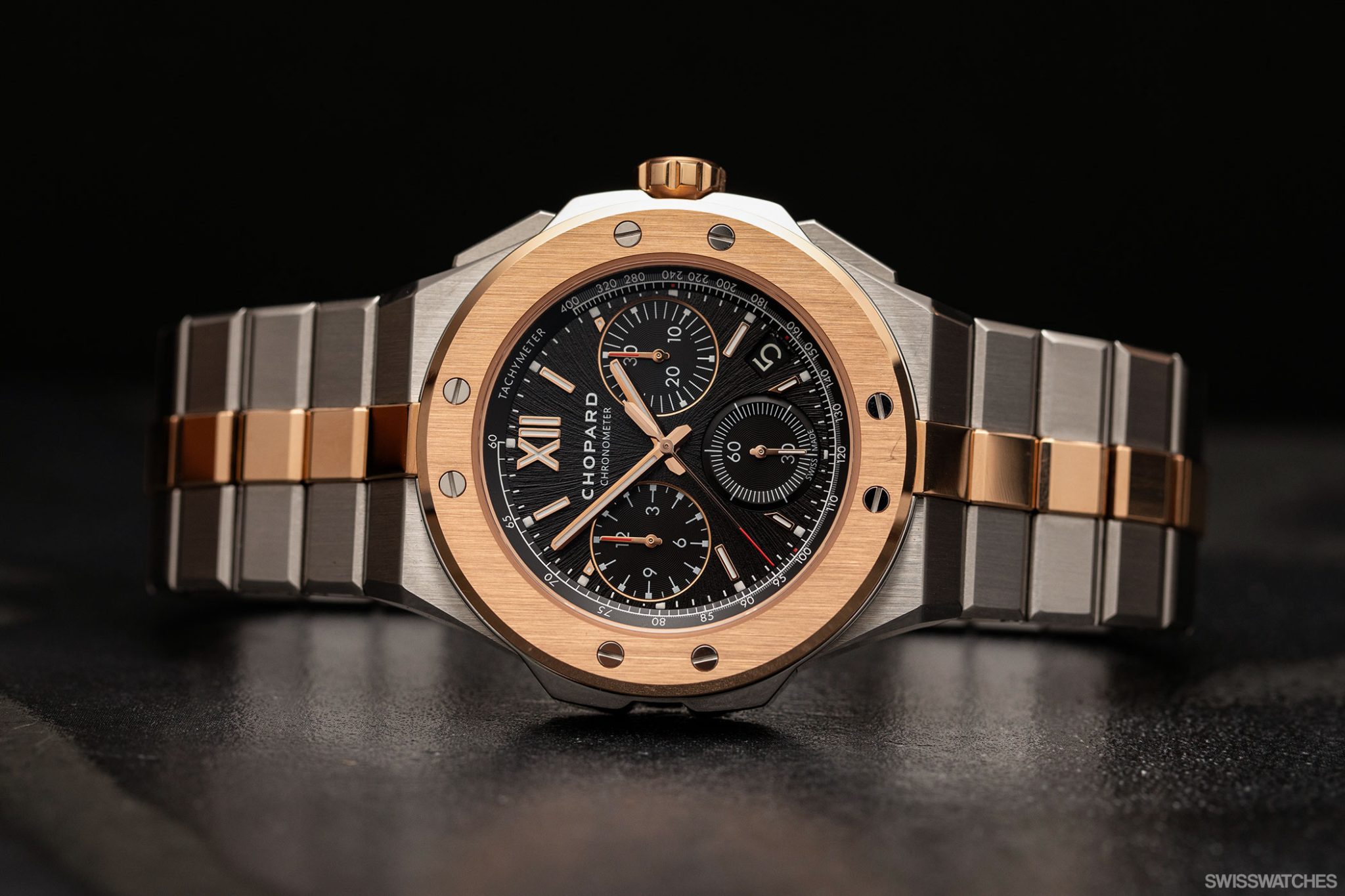
As is ever the case with the Alpine Eagle, the devil is in the details – as can be spotted on the flange, snailed subdial counters, and the bezel ring’s tachymeter scale offering 100, 160, and 240 graduations with red dots for different intervals. In addition, the subdial counters integrate square markers with ‘tails’ for a particularly sporty touch. Finally, the elongated date window is positioned between 4 and 5 o’clock.
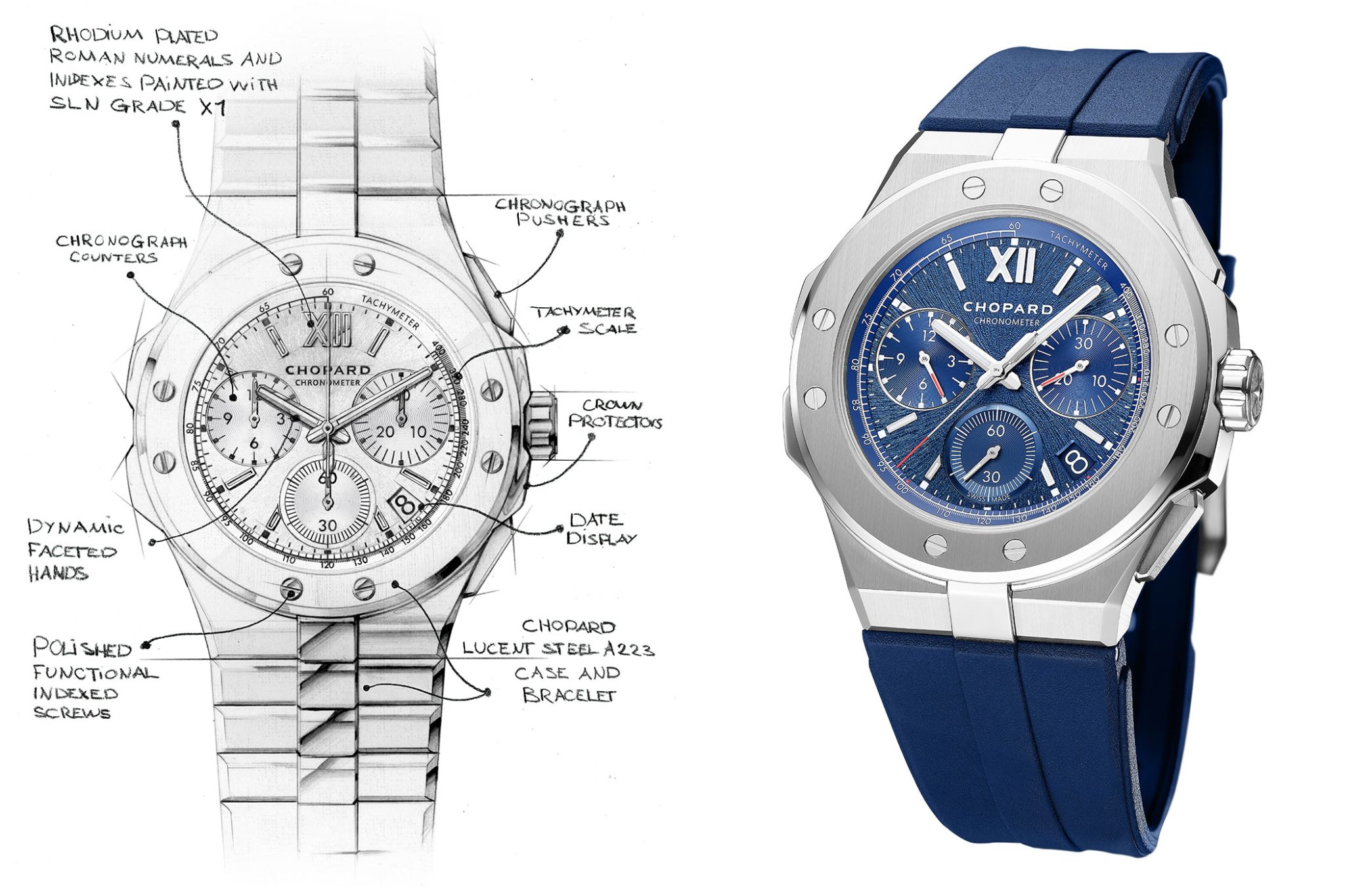
Of course, these chronograph models in Lucent Steel or bicolour (ethical rose-gold and Lucent Steel) are just two examples. There is a plethora of other models available since the launch of these two pioneering pieces, from an eye-catching ‘Maritime blue’ Chrono XL model with a Lucent Steel case, to a warm yellow-gold edition with ‘Pitch Black’ dial paired with a handsome black leather strap with red stitching to compliment the small details on the dial. Essentially, the collection is very versatile – corresponding nicely to Scheufele’s dream for the original St Moritz watch: ‘[…] something I could wear while skiing but also when I put on a tuxedo.’
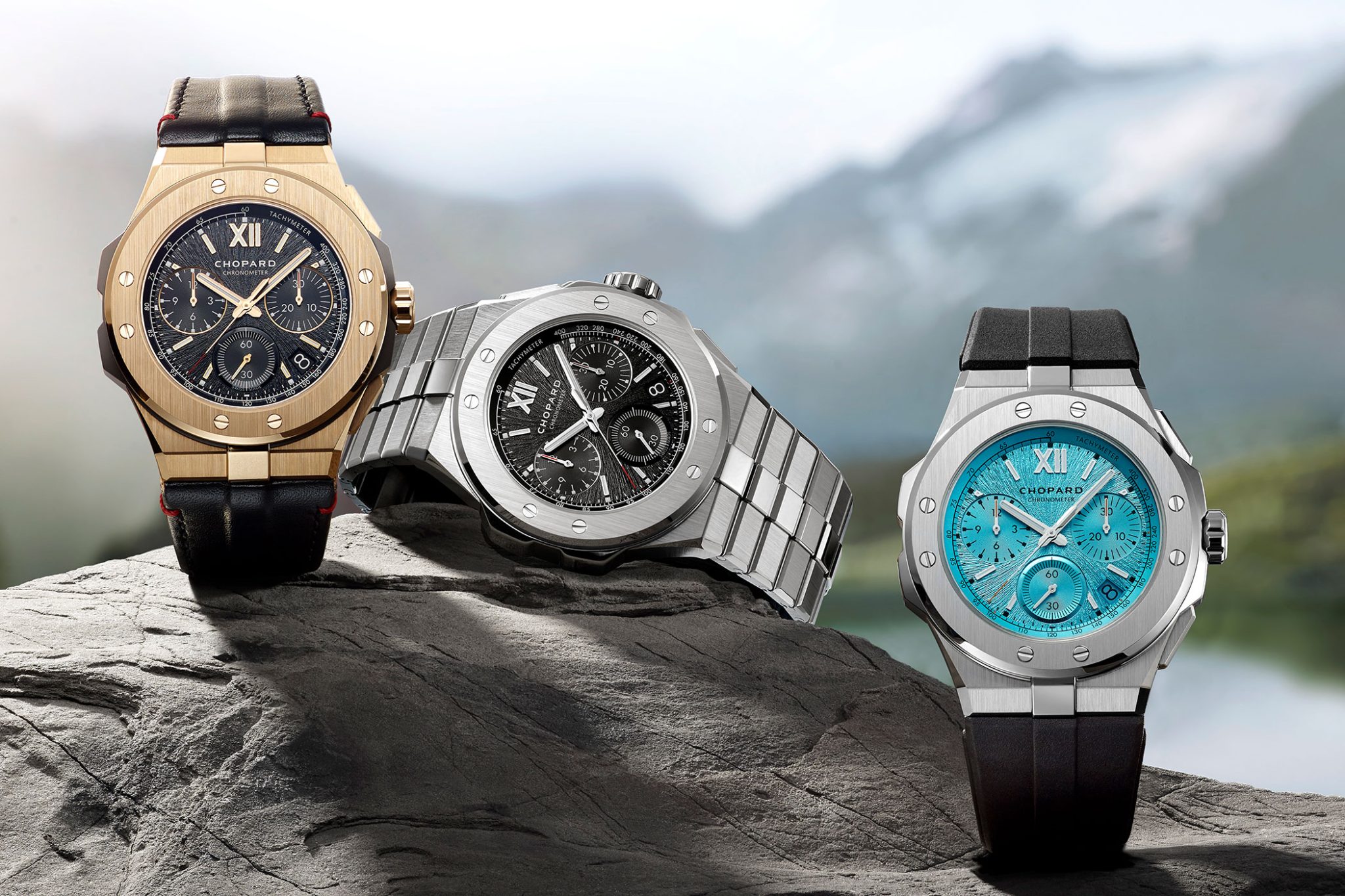
Credit © Patrick Csajko
Another patent, please: Chopard calibre 03.05-C
It’s well worth a dig into the movement behind these XL chronos, and this time it’s the in-house calibre 03.05-C, aka Chopard’s integrated automatic flyback chronograph movement with COSC chronometer certification. With the chronograph function driven by an integrated column wheel and patented vertical clutch to ensure accurate time measurement, it beats at a frequency of 4 Hz and offers a 60-hour power reserve. With many achievements under its belt, the movement holds no less than three patents, and its chronograph function is able to time to one eighth of a second.
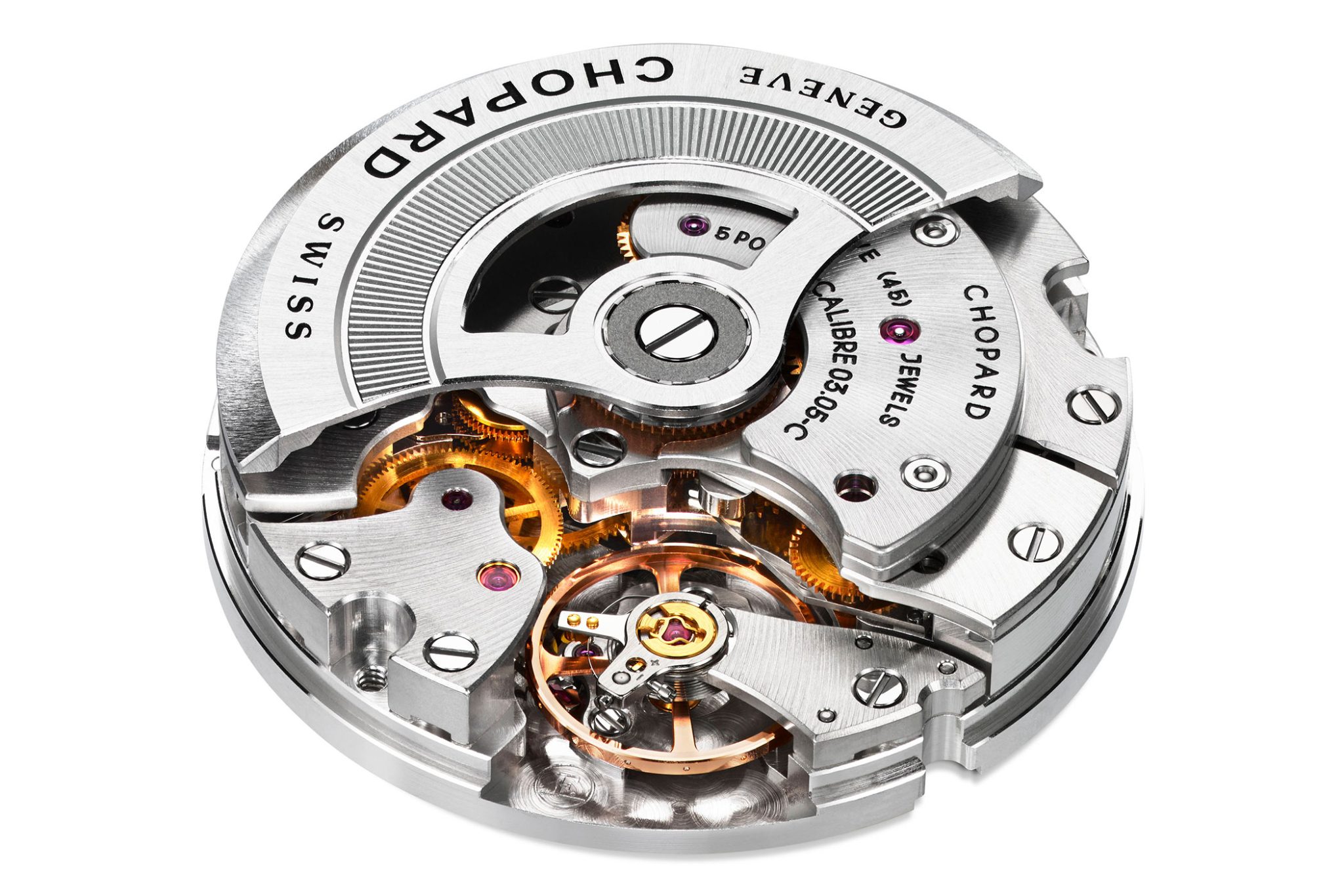
Indeed, as a ‘flyback’ chrono, the watch’s chronograph settings are able to be reset to zero and start running once again, without losing a second. This is achieved with the help of Chopard patented three pivoting hammers with elastic ‘arms’, which set the subdial counters back to zero. In addition, the calibre 03.05-C’s unidirectional gear drive system counters the loss of energy caused by use of the chronograph by ensuring rapid automatic winding. Interestingly, the calibre was devised by Chopard’s engineers for the L.U.C Chrono One. First presented in 2006, the chronograph movement, with its many virtues, from zero-setting to particularly precise jumping minute counter, has gained a stellar reputation, with the Chopard 03.05-C collectively regarded as one of the world’s most innovative chronograph movements to date. Its placement in Alpine Eagle watches should be considered nothing short of remarkable.
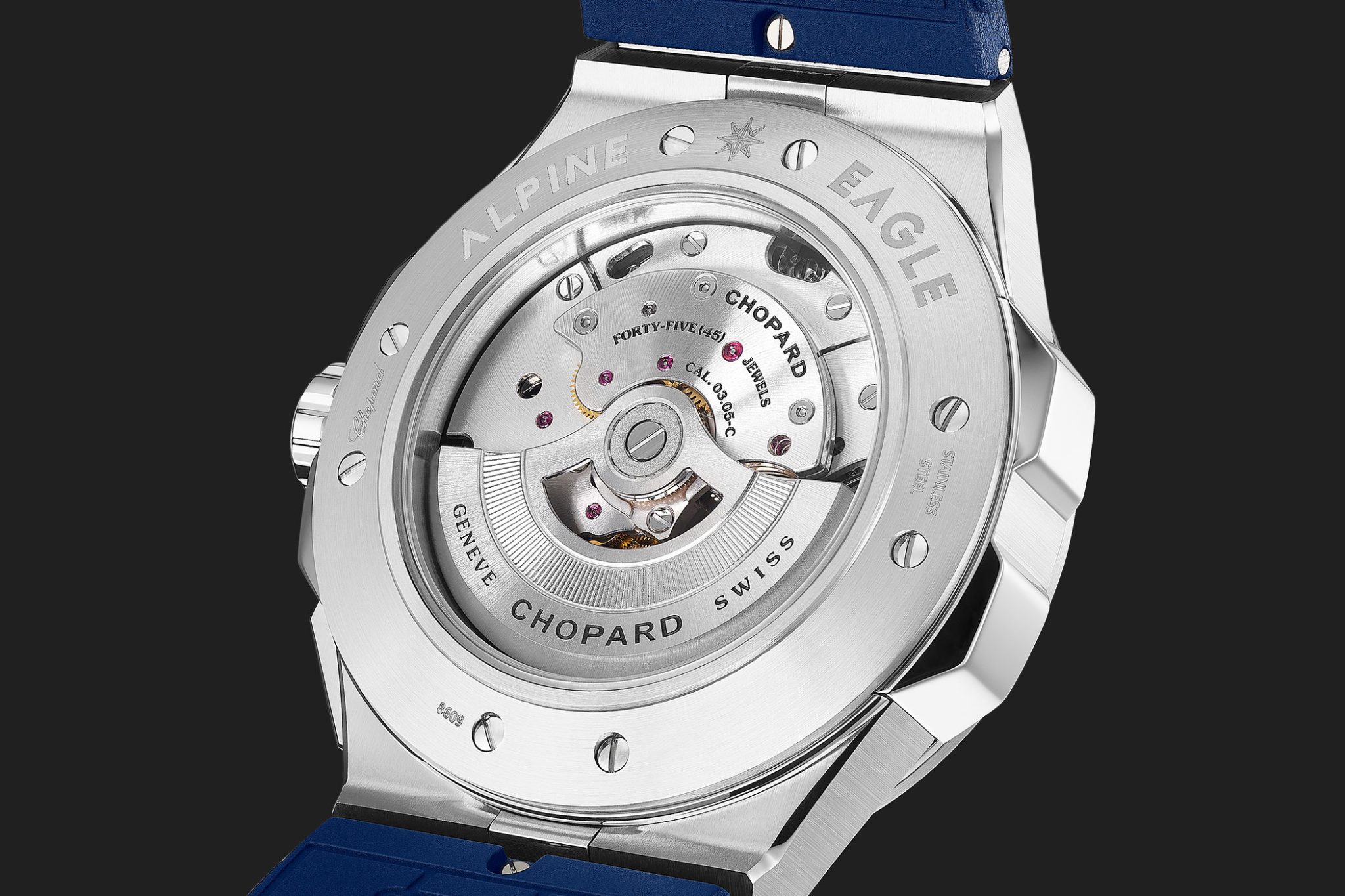
Last but not least, the integration of the XL to the line marked the introduction of another novelty for Chopard’s Alpine Eagle: a rubber strap. Chopard does have a history in rubber straps, first using the material with its famous Dunlop tyre straps for Mille Miglia models back in the mid-90s. The rubber straps of the Alpine Eagle XL Chrono secure to the wrist with a simple pin buckle, and recalls the collection’s famous bracelet with its slight tapering and raised cap. Alternatively, though, the wearer can still opt for a refined bracelet or classic leather strap.
Salmon is a collector’s best friend – Chopard’s Monte Rosa XPS
There’s a shining, dainty shade of pink, dubbed ‘salmon’ by collectors, which is currently considered to be the holy grail of dial colours. Largely reserved for special editions at Switzerland’s top horology houses, the coveted shade of pink was in its zenith throughout 2023, and Chopard was, fortunately, also on board. Alongside a breathtakingly handsome L.U.C 1860 in Lucent Steel, last year the maison introduced a new Alpine Eagle featuring what the brand christened a ‘Monte Rosa Pink’ dial. The shimmering colour brings out the stamped aesthetic of the dial more effectively than any other piece in the collection, seducing Chopard Alpine Eagle fans once and for all. Surely designed with collectors in mind, the nevertheless unlimited Alpine Eagle XPS forgoes the 4:30 date window in favour of a snailed small seconds counter at 6 o’clock. What’s more, the resplendent watch with sapphire crystal caseback is powered by the calibre L.U.C 96.40-L, showcasing impressive finishing and precision that has led to not only the classic chronometer certification but also the Geneva Seal. Truly the epitome of Chopard.
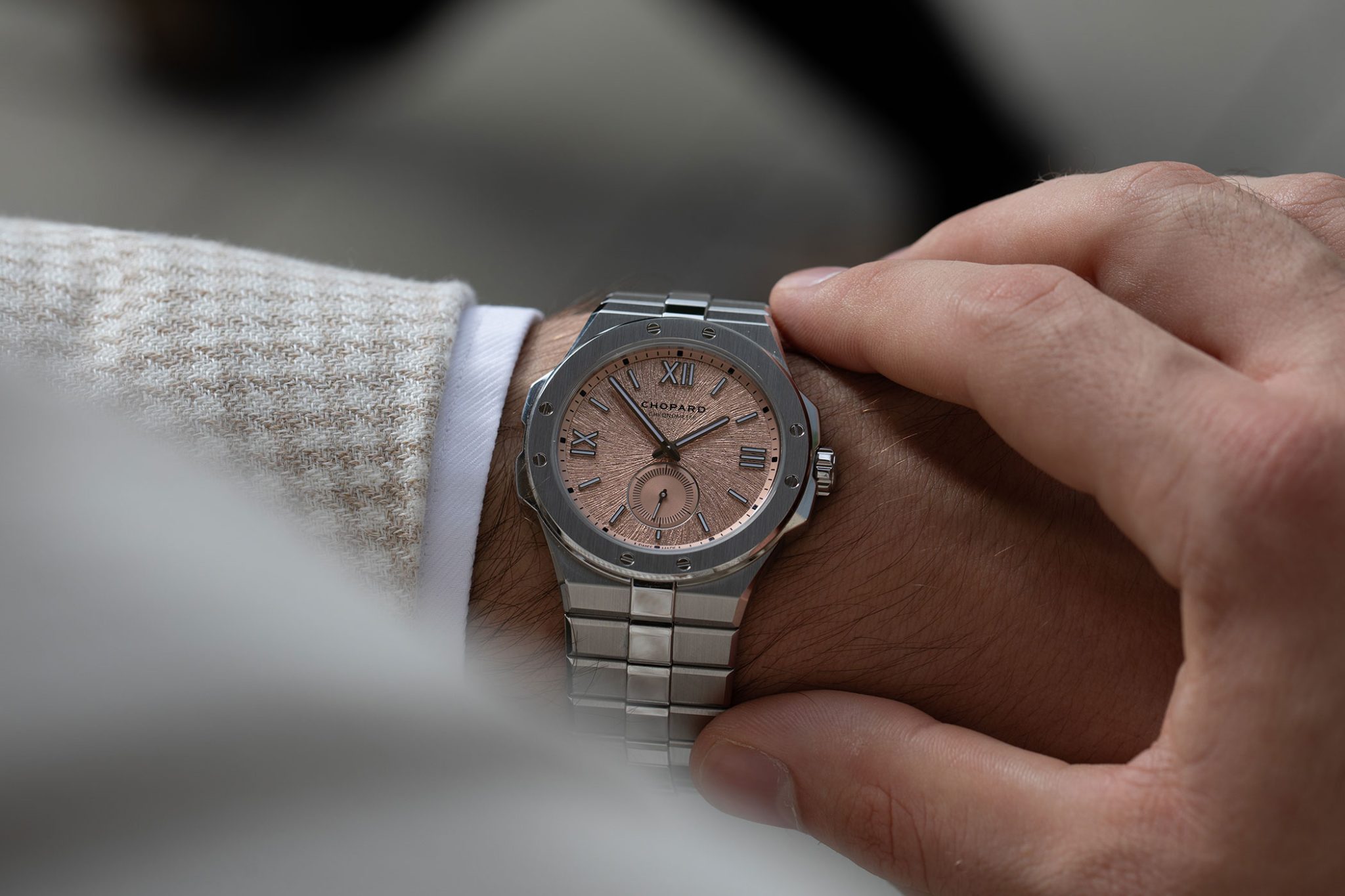
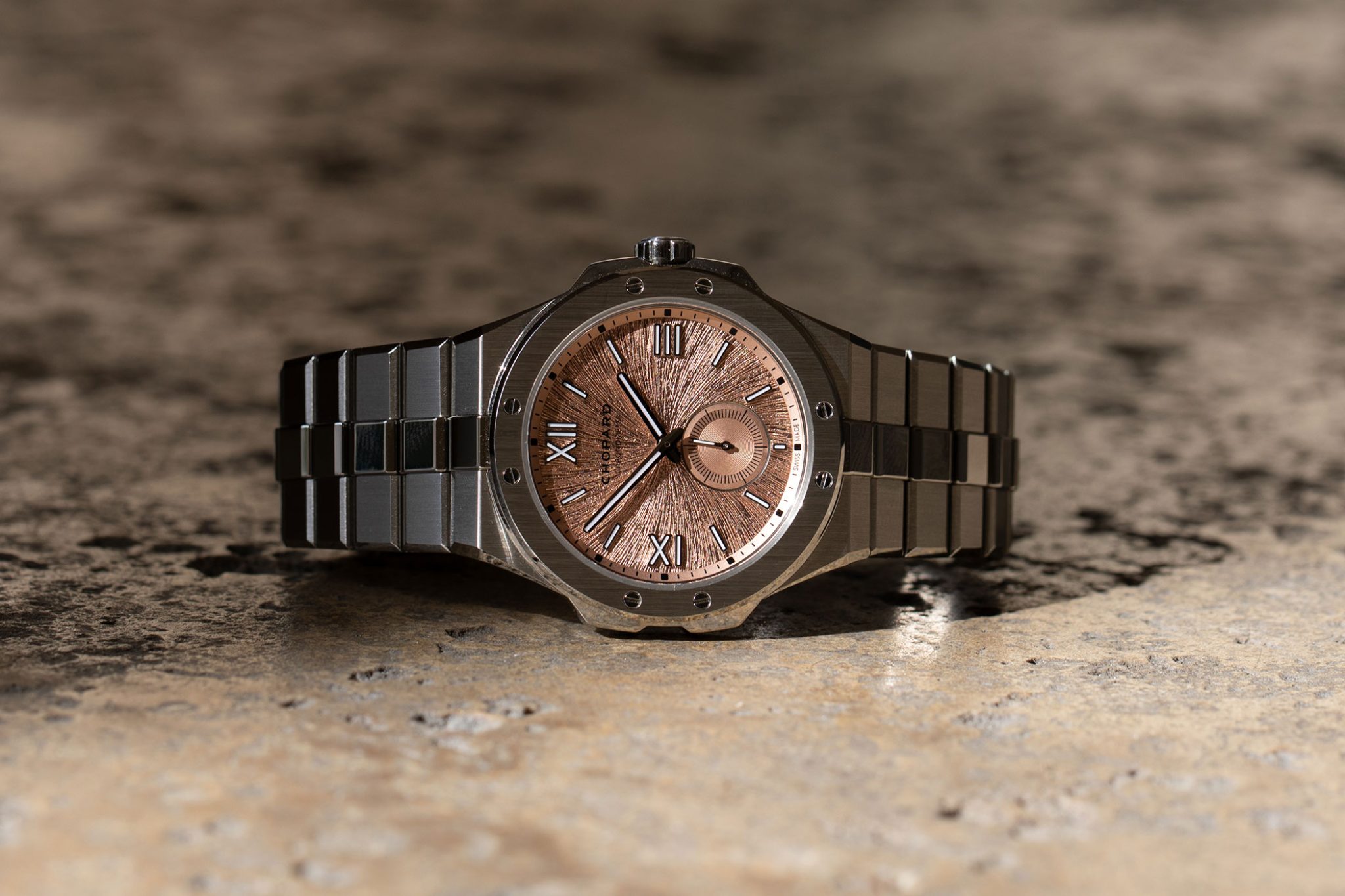
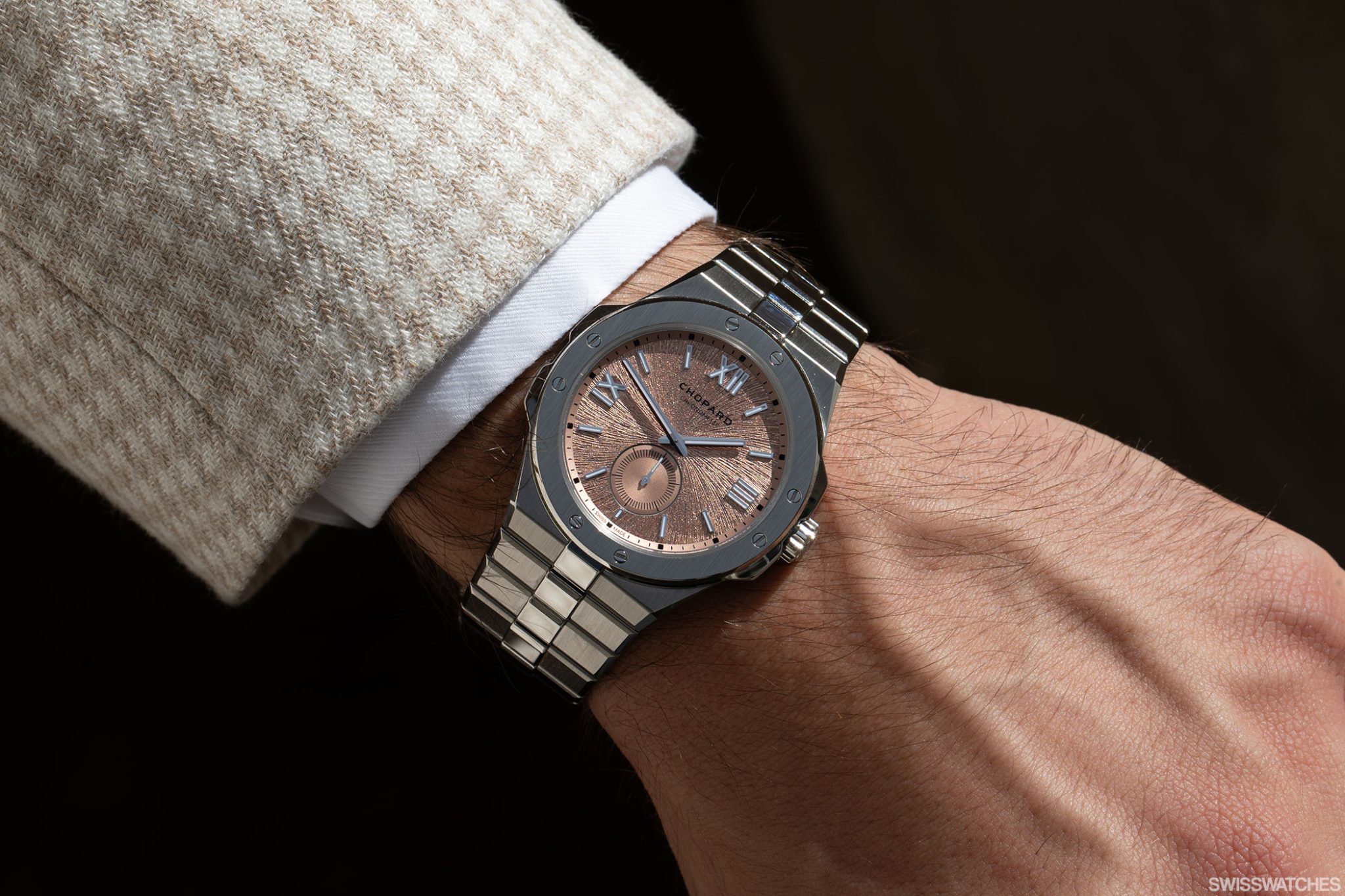
Complications and craftsmanship: The Alpine Eagle Flying Tourbillon
Our final watch on our tour through the collection’s horological highlights is the 41 mm Alpine Eagle Flying Tourbillon, introduced in 2022 (how time flies). The Alpine Eagle Flying Tourbillon is all about showcasing Chopard’s highest horological skillset, integrating a complex mechanism into a pretty slim movement. We have another LU.C movement in this watch, and this time it’s the L.U.C 96.24-L, which measures a mere 3.30 mm in height.
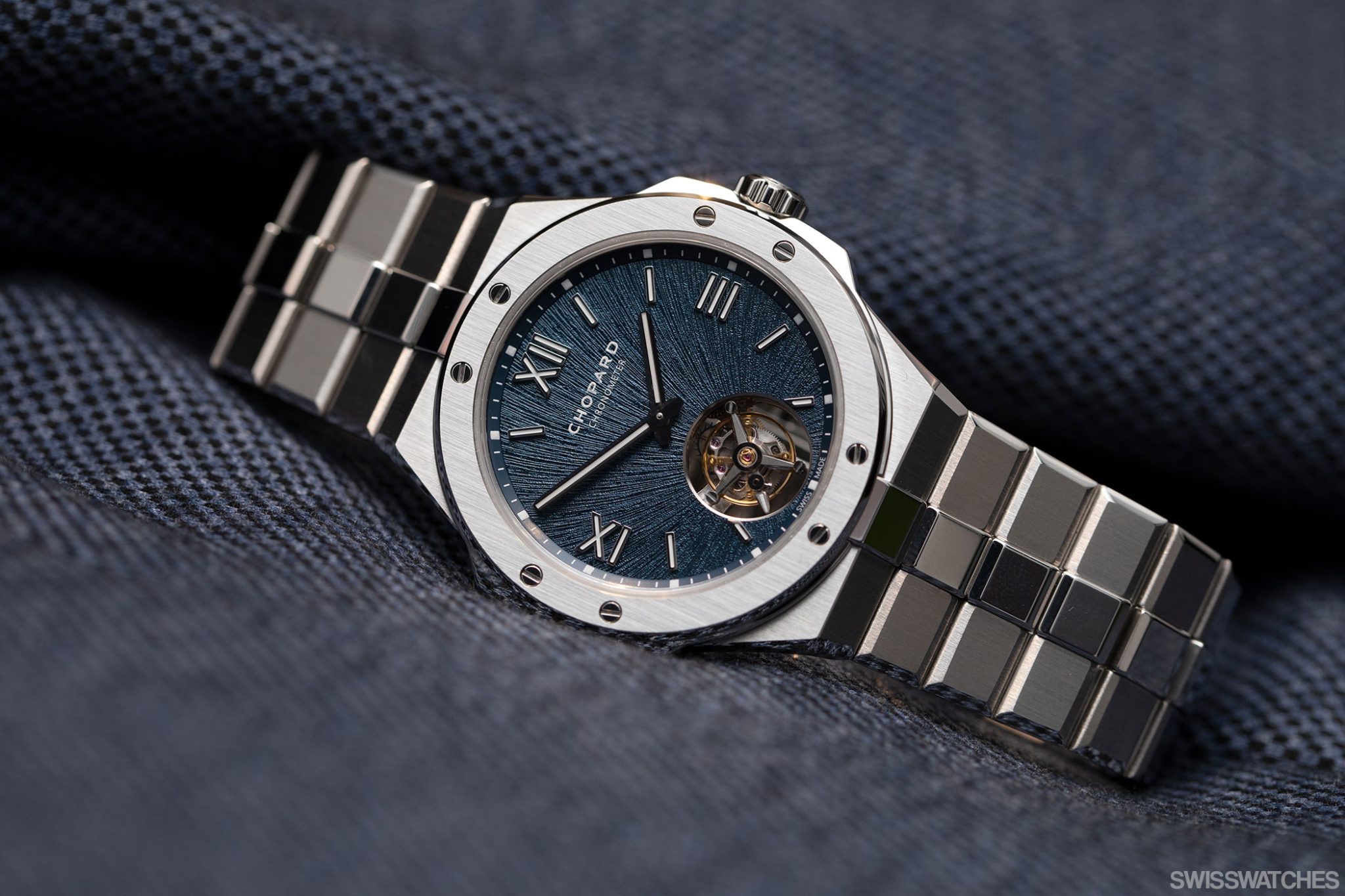
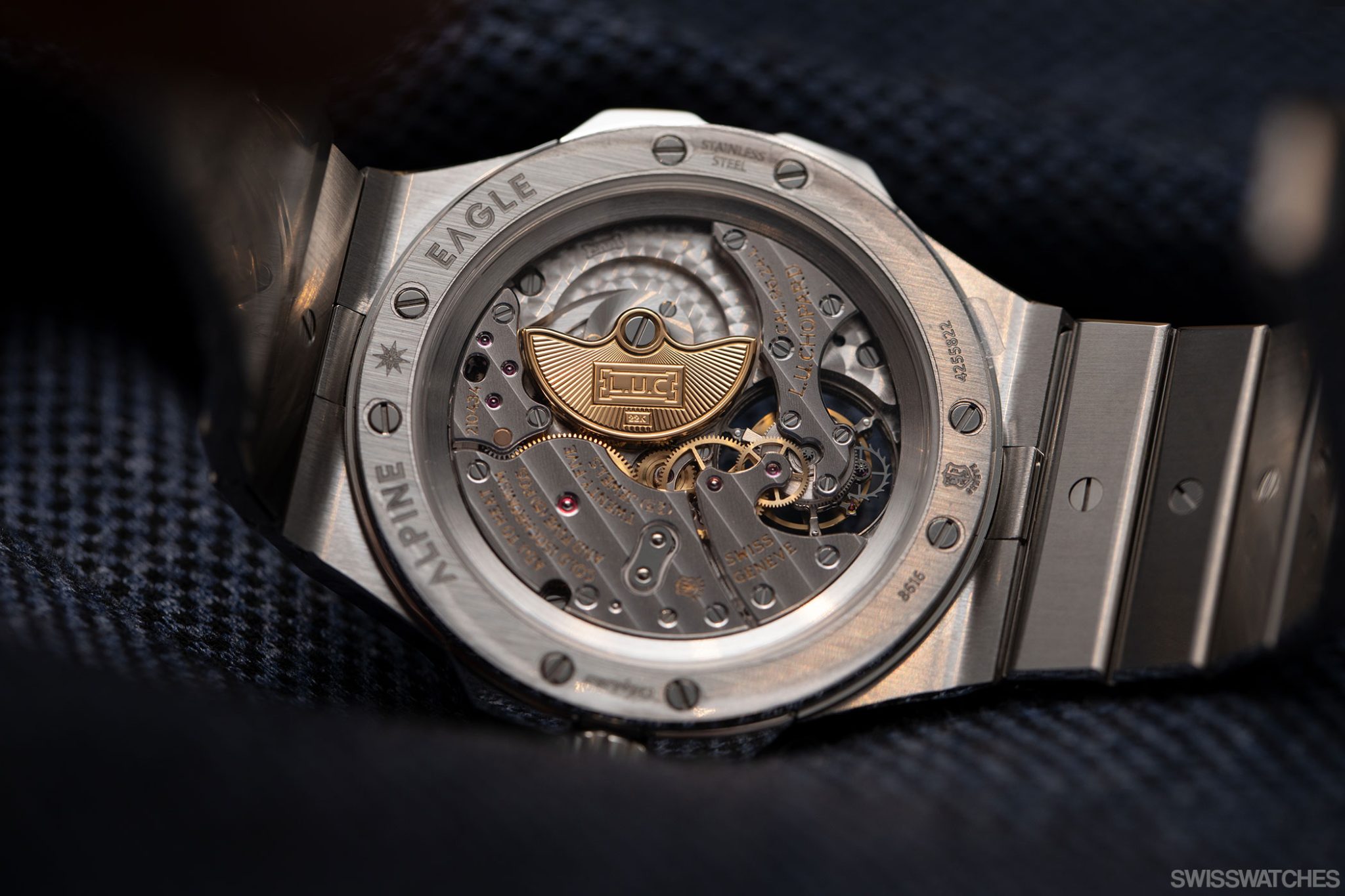
As a result, the case is able to boast a height of only 8 mm. This is one of the very rare flying tourbillon watches out there to hold both a chronometer and Poinçon de Genève certification. Through the caseback, the owner of the watch can admire the 22-carat gold micro-rotor, beating at a frequency of 3.5 Hz, with its Côtes de Genève motif. In addition, a variable-inertia balance wheel allows for extremely precise regulation. The model exemplifies what Chopard watches are all about: innovative design and precision.
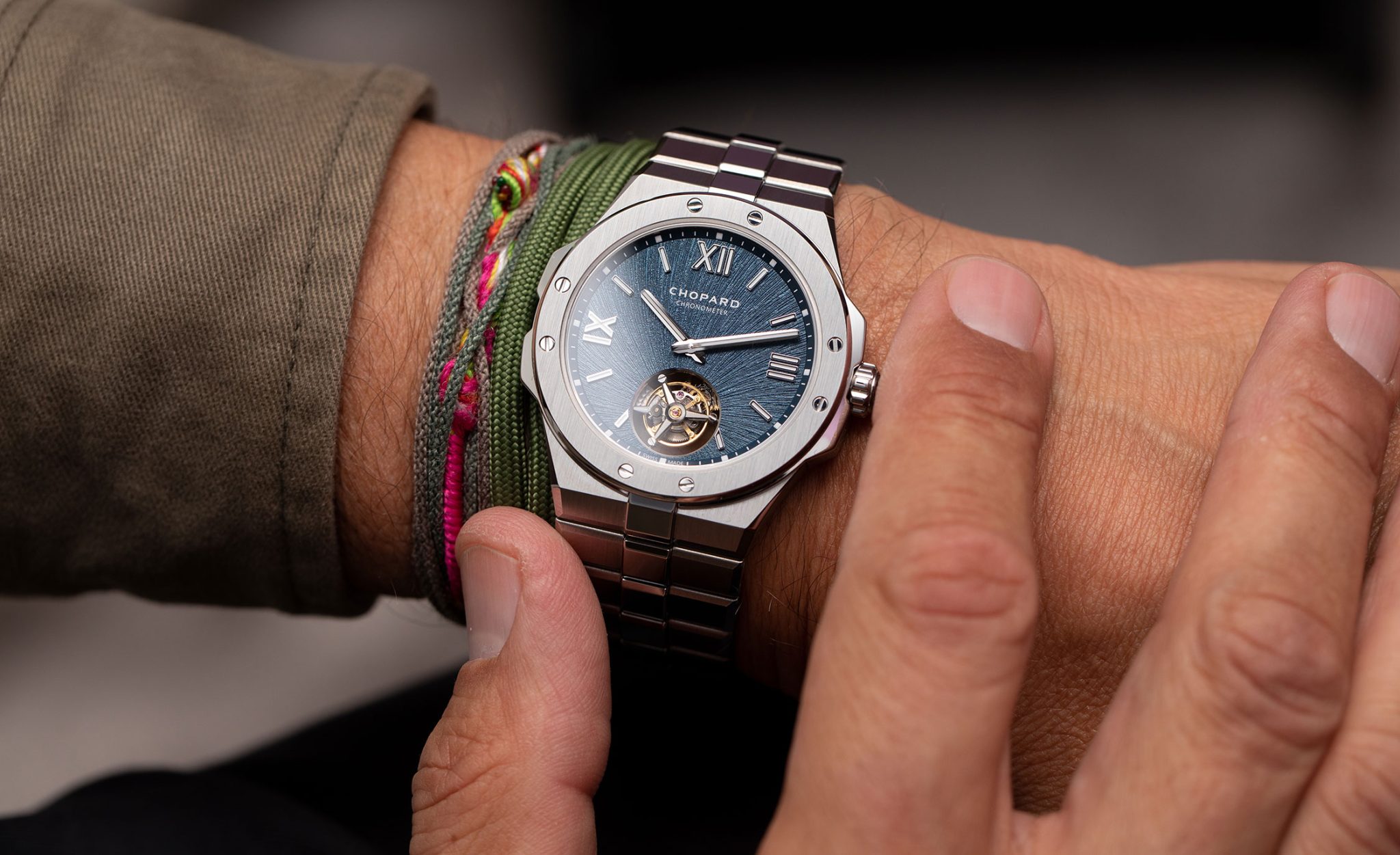
Pricing of the Alpine Eagle
The lowest priced Alpine Eagle (a 33 mm automatic three-hand watch in Lucent Steel) costs 11,500 euros, while the most expensive price communicated for an Alpine Eagle on Chopard’s website is 191,000 euros (the 41 mm fully diamond paved Ref. 295363-1001). The handsome XPS with Monte Rosa Pink dial is 26,100 euros, while the Pine Green dial watch in yellow-gold is 60,300 euros. The XL Chrono with its alluring Aletsch Blue dial and steel bracelet, on the other hand, has a 23,200-euro price tag, while by contrast, the flying tourbillon has a price of 136,000 euros.
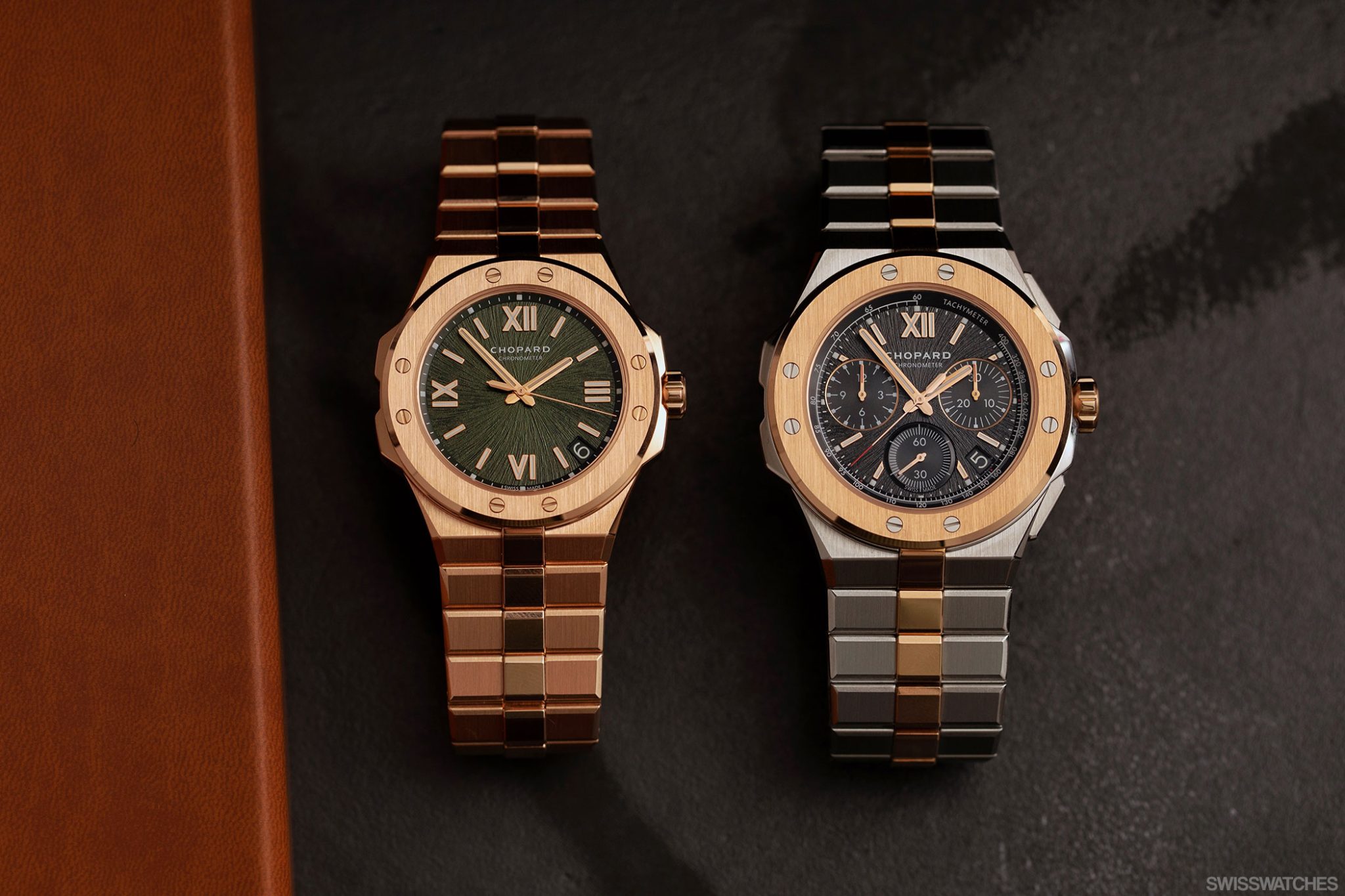
These numbers give us an indication of the collection’s positioning. The pricing places the Alpine Eagle – specifically the listing price, not on the pre-owned market – firmly in the segment with other absolute top luxury sports watches to come out of Switzerland. Whether this pricing is reasonable should, as always, be up for discussion: in my eyes, however, the pricing is perfectly rational. Take, for example, the XL chronograph, which uses the one-of-a-kind calibre previously only seen in the top-level L.U.C, now integrated into an accessible main collection model. Let’s also remember that the Alpine Eagle has a different story to the Mille Miglia, and was arguably never specifically designed to morph into a collector’s favourite – but, just like no one expected a diver’s watch from Montblanc, it has become an all-round success amongst serious collectors and men perusing the luxury sports watch segment alike.
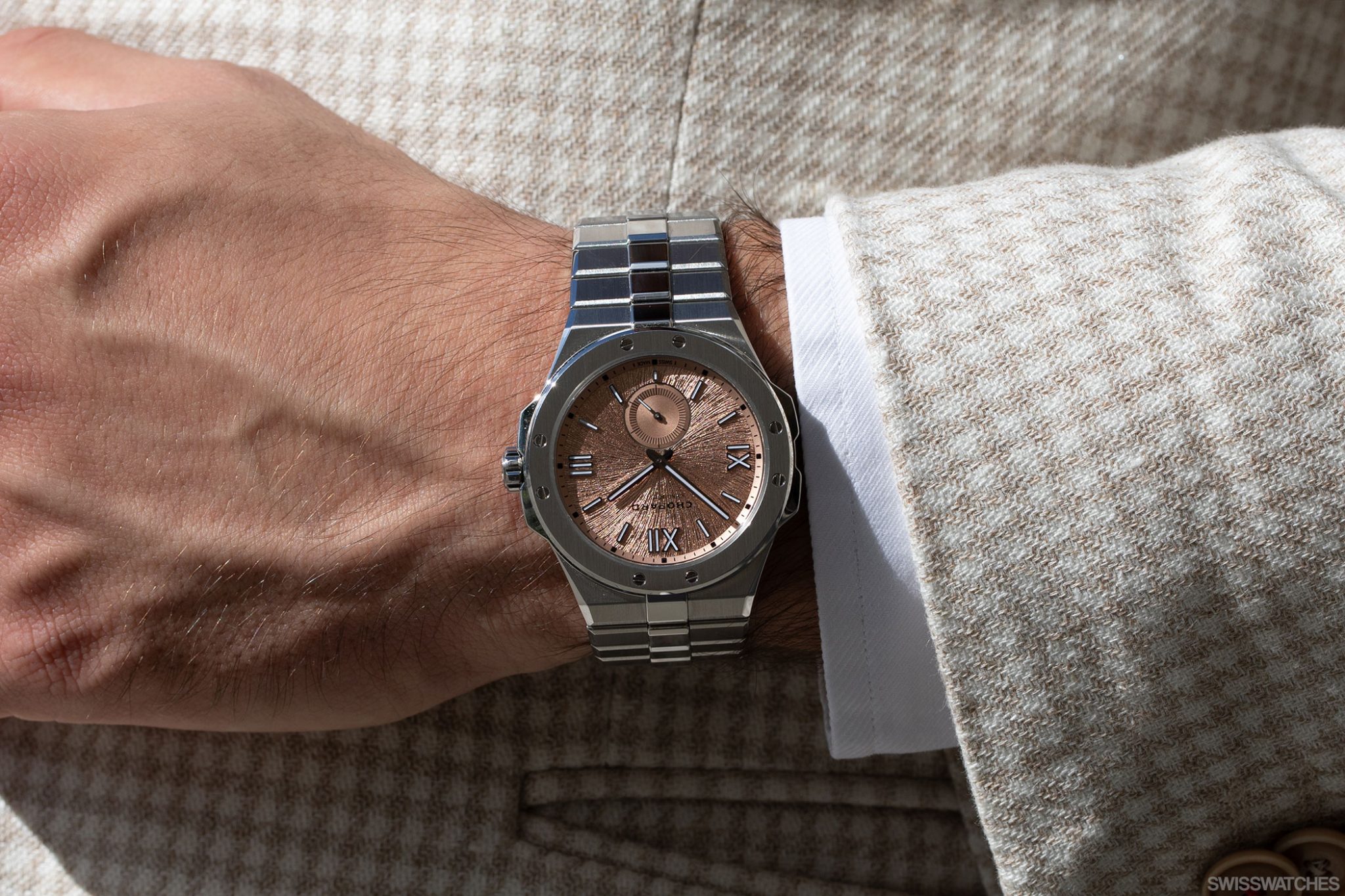
This achievement in itself also points to the future as luxury watches inevitably begin to play a different role in the overlapping world of fashion – just look at Louis Vuitton’s unprecedented leaps and strides in recent years under the wing of La Fabrique du Temps. The quality of the Alpine Eagle as a product and top-of-the-league manufacture movements makes for a sure-fire favourite amongst many aficionados. Finally, the company’s very modern approach of striking fast and moving quickly has served Chopard well, with its swift reaction to the market arguably serving as a key factor in the Alpine Eagle’s overall success, as well as its justification of price.
Alpine Eagle: From novelty to emblem of the brand
Enough of the sentiment and enough of the scrutiny, though. What we have really learned on our journey through the Alpine Eagle, while studying only a handful of watches, is that quality lies at the heart of the collection. Of course, the design is also, in my personal opinion, exquisite – but it is the unfailing attention to detail throughout the production process that sets these luxury timepieces apart, and it certainly shines through in the finished product. As with every good watch, there’s the story, too: a story of grandfather, father, and son, each of which have adapted to the times and trends while honouring the wisdom of their forefathers. While this was once a watch that marked Chopard’s decision to acknowledge a sign of the times, simultaneously promoting the luxury lifestyle of the brand with its glamorous affinity to St. Moritz, the reimagined Alpine Eagle also encapsulates the soul of its Co-President and his family’s passion for the beauty of Switzerland’s natural as well as horological world.

Credit © Uni Bern
Finally, it’s a watch of great speed: over barely half a decade, the Alpine Eagle collection has taken flight to become a vast and varied line with numerous models, appealing to men and women across the board. It’s fair to say we have never before seen this level of development and growth throughout such a short time-frame. While other brands such as Patek took 30 years to convince people of their own cult classics, the Alpine Eagle took only one tenth of the time to become a collector’s piece, and continues to enjoy increasing levels of attention.
But if this is the case, and the watch continues to advance at its current pace, where might the Alpine Eagle take us next? Is Chopard’s timepiece, as some are dubbing it a ‘threat to the Holy Trinity’? Or is the Alpine Eagle to be seen the way I see it – as the gift that just keeps on giving?





